From June 26 to 28, 2024, the Shanghai International Auto Lamp Exhibition (ALE) was held at the Huaqiao International Expo Center in Kunshan, China, bringing together thousands of participants from renowned Chinese and international original equipment manufacturers (OEMs), top automotive lighting companies, and numerous automotive LED enterprises.
During the event, LED-related companies showcased an array of automotive lighting products and displays, including ams OSRAM, Seoul Semiconductor, BOE HC Semitek, Nationstar, Honglitronic, LatticePower, Refond, LIGHTNING, SUNPU, APT, Retop, DOMINANT Opto Technologies, Macroblock, LITEON, Lextar, Brightek, CHIPFOUNDATION, Xingyu, and Ledman.
Headlights
Adaptive driving beam (ADB) headlights continue to be the highlight of this exhibition, particularly matrix LED headlights and Micro LED headlights. ams OSRAM, BOE HC Semitek, Nationstar, LITEON, and CHIPFOUNDATION all showcased products based on Micro LED technology. Additionally, Seoul Semiconductor, Refond, Honglitronic, LatticePower, and LIGHTNING displayed various ADB headlight modules.
ams OSRAM presented the EVIYOS 2.0 high-pixel projection headlight at the exhibition. This product features 25,600 individually controllable Micro LEDs, with a pixel pitch of 40 micrometers, enabling fully adaptive dynamic operation and image projection. The headlight is currently in mass production and widely used.
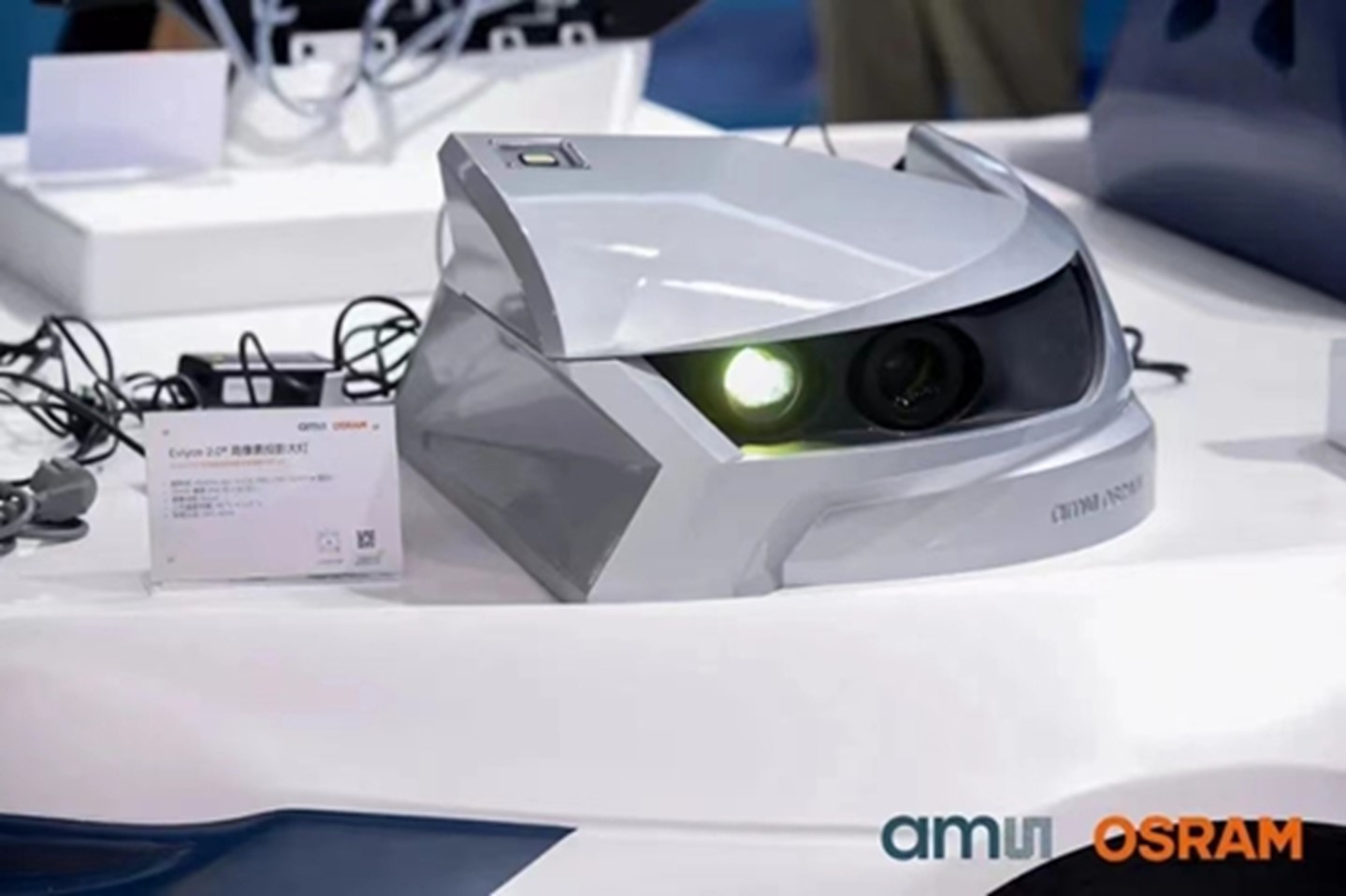
ams OSRAM ENVIYOS 2.0 high-pixel projection headlight (image credit: ams OSRAM)
In response to the rise of ADB headlights and ultra-thin headlights, Seoul Semiconductor has focused on developing WICOP, nPola, and ultra-high luminance (UHL) technologies. The brightness of WICOP (G3) has been increased from 375lm to 450lm. nPola, which emphasizes high brightness and high current, has already been adopted by Chinese and Korean car manufacturers. UHL-based products feature an excellent compact size with a light-emitting surface (LES) of only 0.54mm².

Seoul Semiconductor automotive product solutions (image credit: Seoul Semiconductor)
BOE HC SemiTek showcased its Micro LED ADB matrix-pixel headlight module for the first time at the exhibition. This module, based on Micro LED technology, achieves precise pixel control and flexible illumination area adjustment without the need for DLP projection modules. By using a CMOS control circuit, it realizes source-level high-definition imaging, enhancing the performance of adaptive headlights.
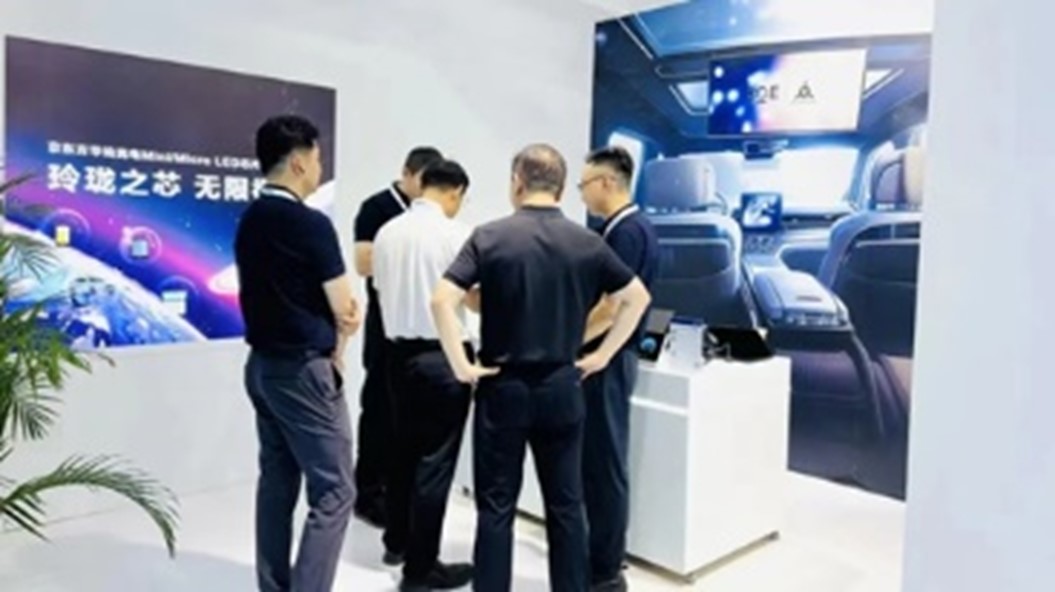
Micro LED ADB matrix-pixel headlight module from BOE HC Semitek (image credit: BOE HC Semitek)
Nationstar exhibited its Micro LED pixelated headlight, equipped with bonding technology to integrate a micrometer-level blue LED chip array into a CMOS control circuit, allowing for the independent control of individual pixels within the Micro LED array. This light source features over 40,000 LED lighting units with a pixel pitch of 40 micrometers, enabling high-resolution image display.
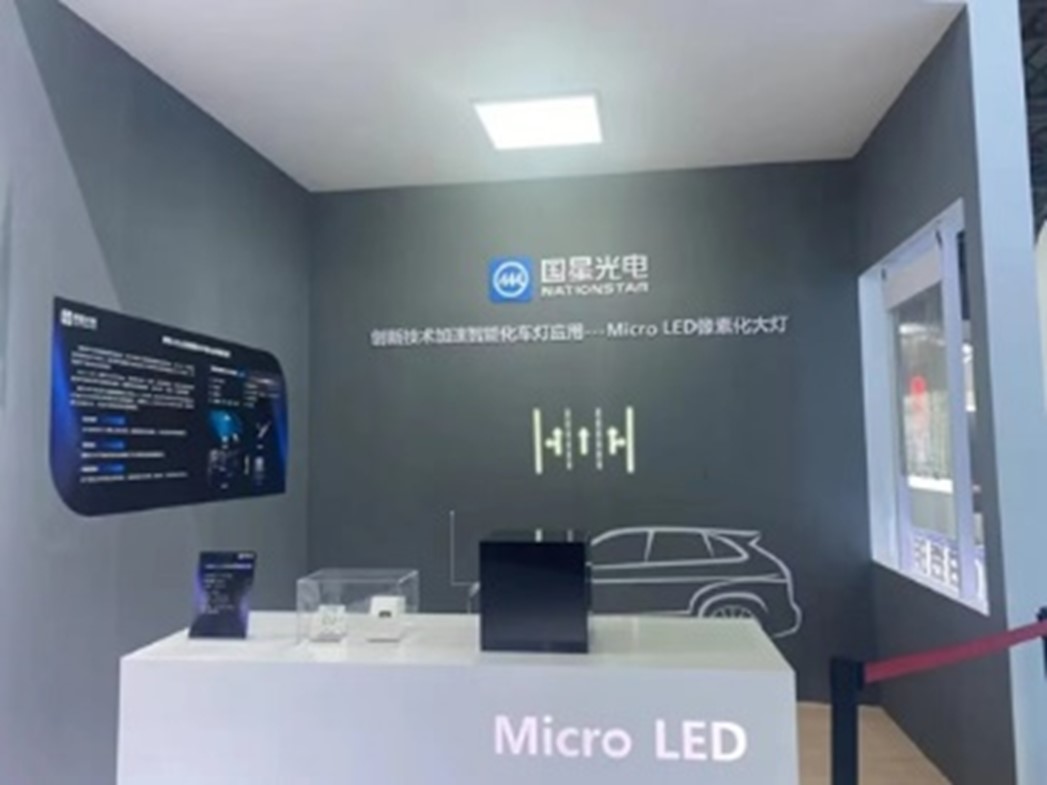
Nationstar Micro LED pixelated headlight (image credit: Nationstar Optoelectronics)
LITEON introduced an advanced Micro LED headlight module and an ultra-high power LED smart light source. Equipped with million-pixel-level digital micromirror technology, they enable dynamic and personalized design and application, capable of clearly projecting icons, text, and other information onto the ground.
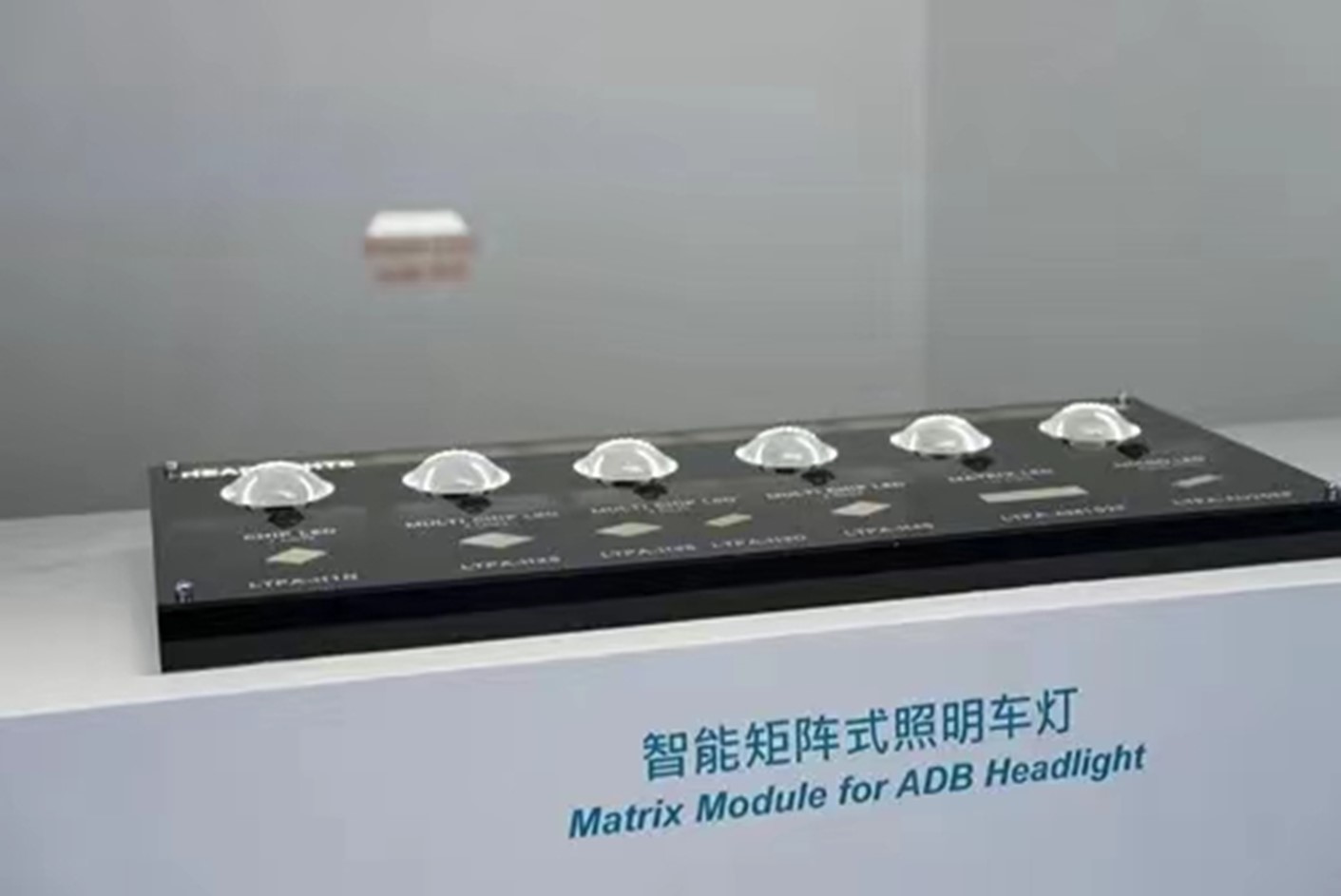
LITEON smart matrix headlight (image credit: LITEON Technology)
APT showcased a high-power (3W) LED headlight, which has already been applied in over 300,000 vehicles on the market. Its automotive LED products have cumulatively been integrated into more than 2 million vehicles. Additionally, the manufacturer displayed a 32-pixel integrated matrix headlight and the 3040 32-pixel ADB module, which features a pixel pitch of 0.1mm.
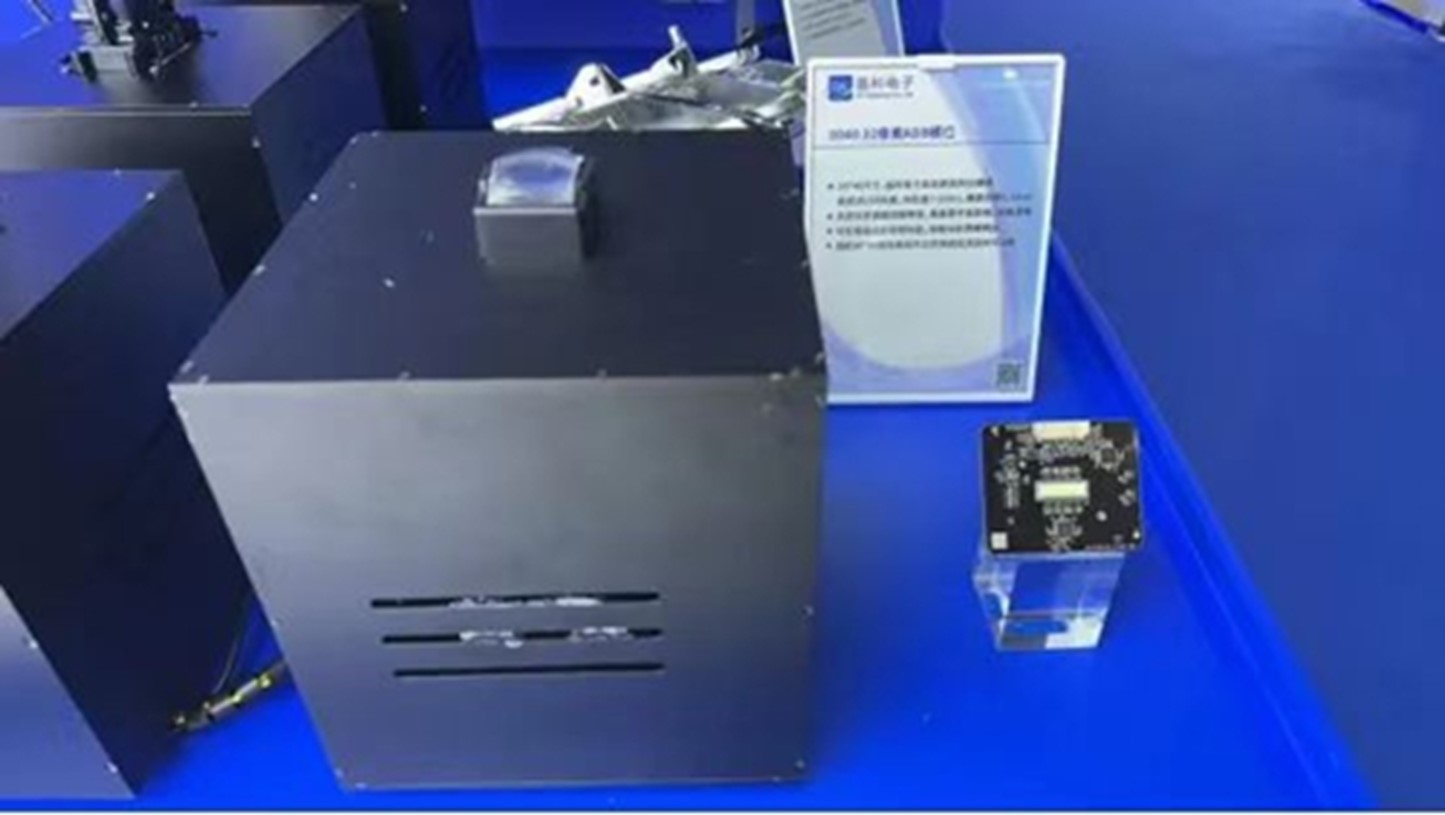
APT 3040 32-pixel ADB module (image credit: APT Electronics)
Refond revealed a new COB-based ADB module, offering high performance and high reliability. This integrated light source and driver module achieves a pixel pitch of less than 80 micrometers through laser barricades, effectively addressing issues of light crosstalk. It provides solutions with 102, 84, 48, and 24 pixels, balancing the performance and cost.
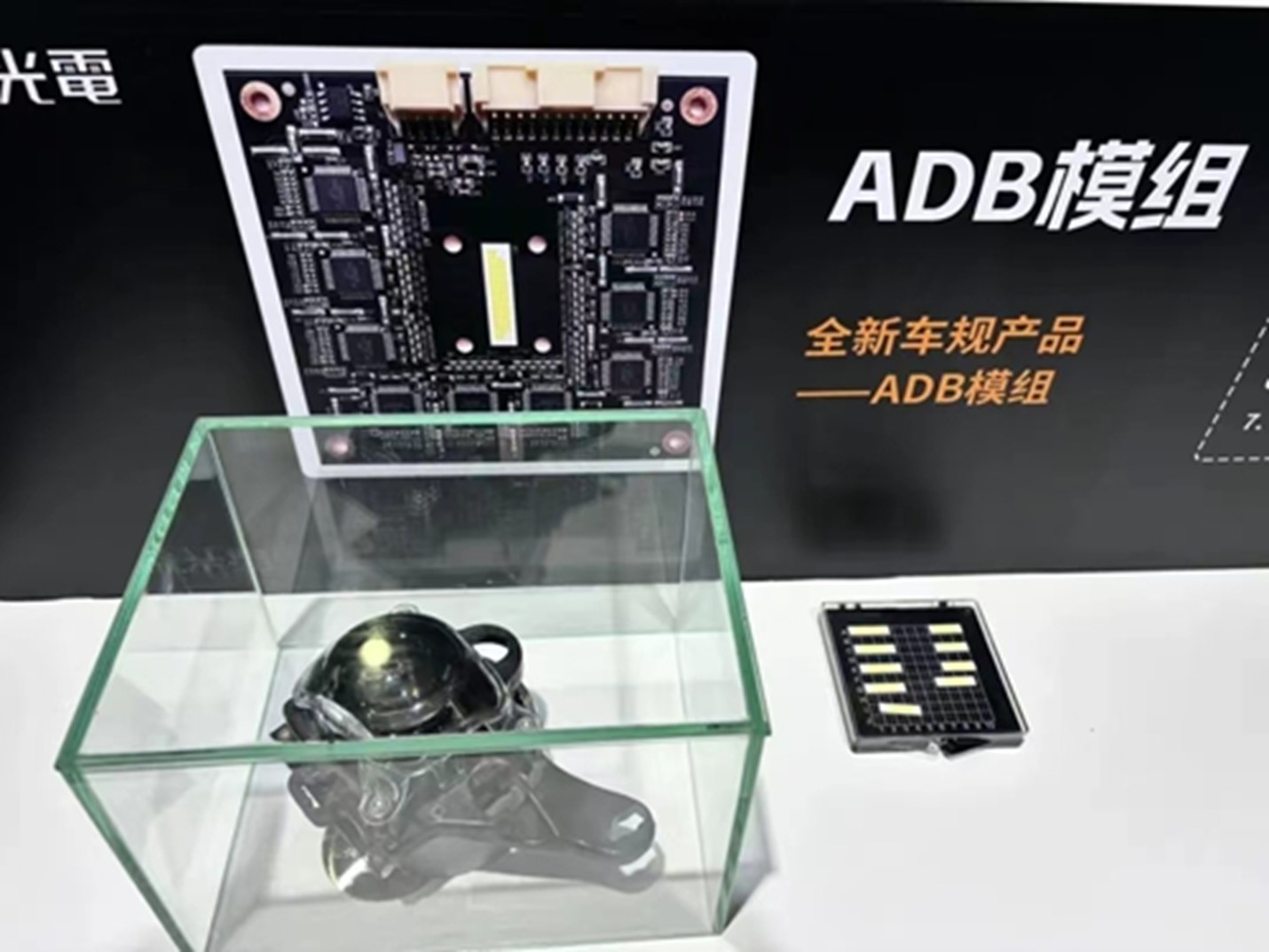
Refond ADB module (image credit: Refond Optoelectronics)
Honglitronic’s ADB headlight is powered by a 96-pixel light source and excels in optical performance. The company employs advanced intelligent image recognition algorithms to enable the product to continuously and stably track multiple people and vehicle targets, quickly identifying traffic conditions. With a smaller module size, the headlight is highly adaptable to the overall lamp designs of various car models, meeting customer needs for innovative headlamp designs.
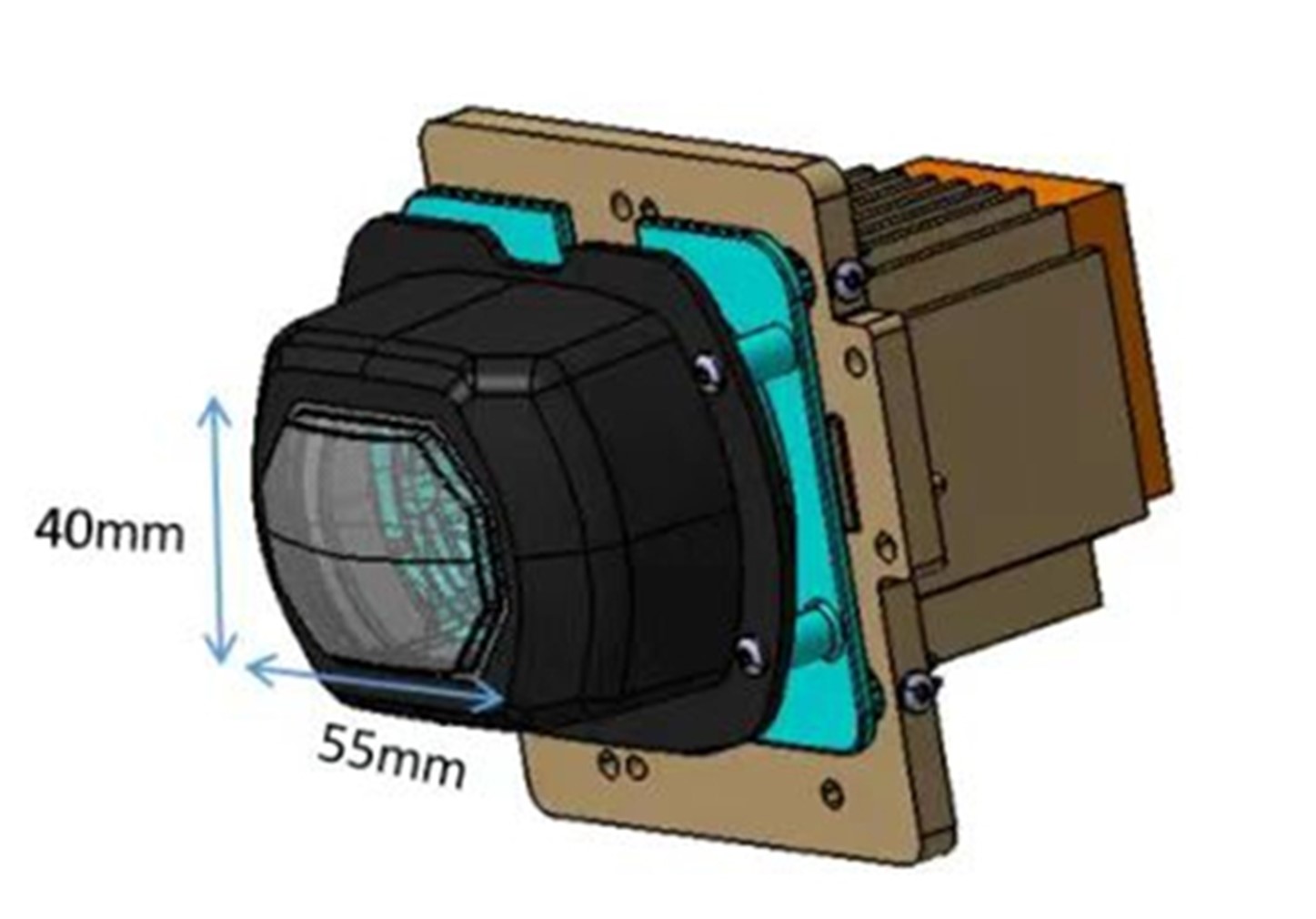
Honglitronic ADB headlight (image credit: Honglitronic)
LatticePower showcased two ADB matrix headlight modules. One is based on silicon substrate LED chip technology, offering high optical and color purity, strong vertical illumination, and a more compact size in overall headlamp design. The other is equipped with CSP LEDs, providing advantages such as flexible design, shorter demonstration time, and customizable chromaticity in module product development.

LatticePower ADB matrix headlight modules (image credit: LatticePower Corporation Limited)
The Integrated ADB Product Solution introduced by LIGHTNING offers more intelligent high beams with more compact design.
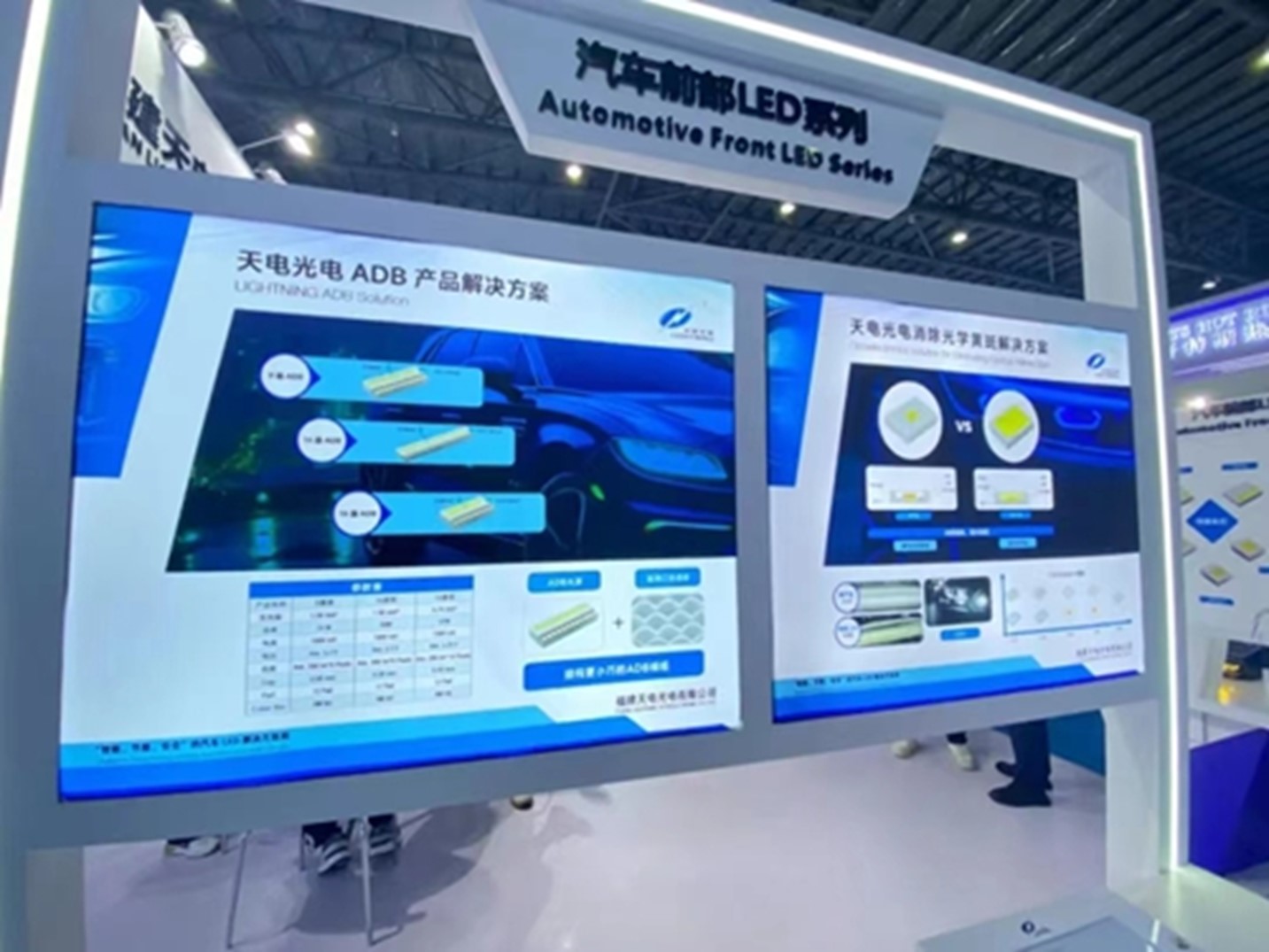
LIGHTNING ADB Product Solution (image credit: LIGHTNING Optoelectronic)
DOMINANT Opto Technologies presented its JKW-TZHY and JKZY-TZHS packages, which are suitable for automotive low beams, front fog lights, and daytime running lamps.
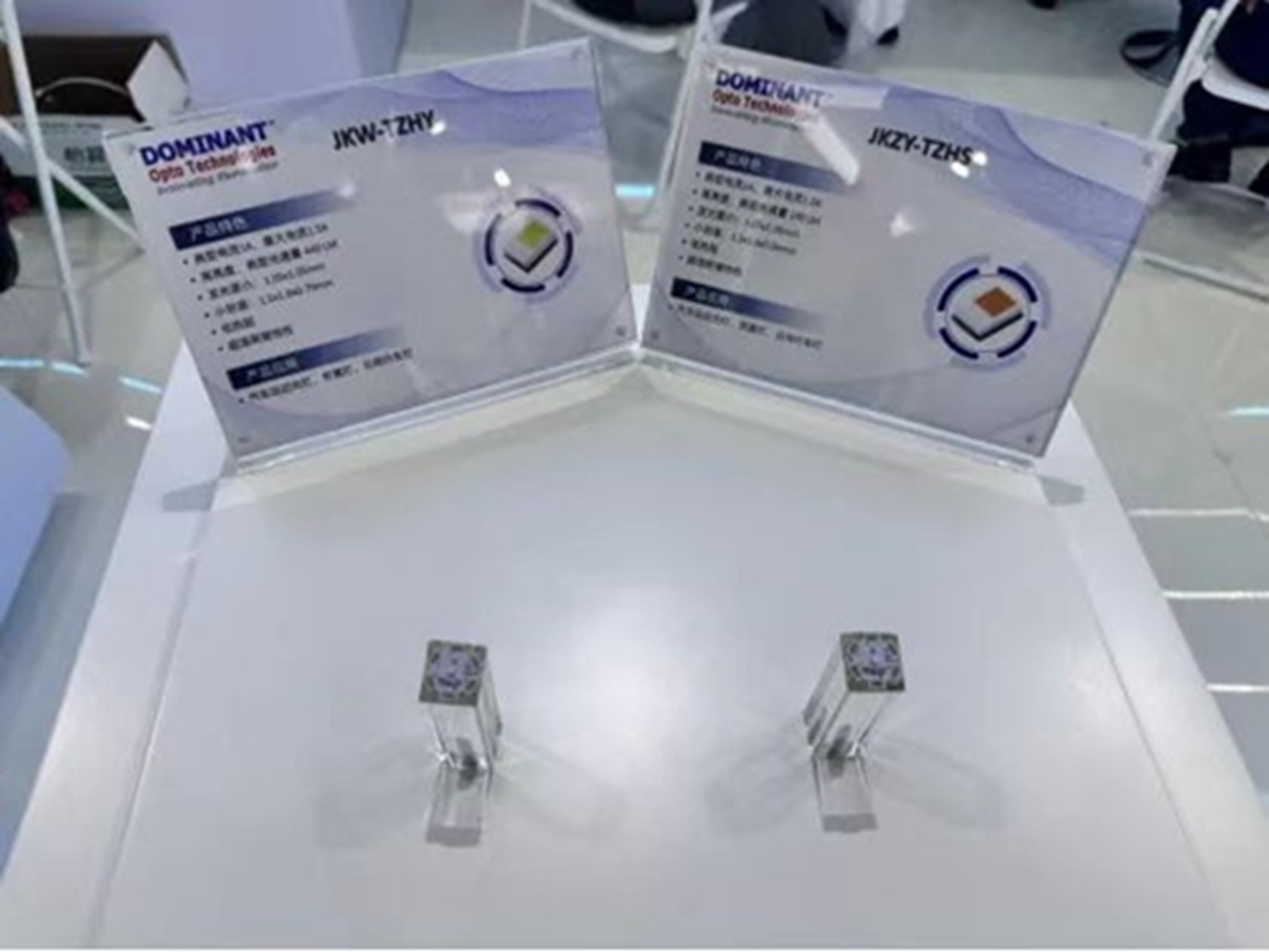
DOMINANT JKW-TZHY and JKZY-TZHS packages (image credit: DOMINANT Opto Technologies)
Lextar’s ADB headlight comes with a high-zone (local dimming) LED design, featuring high-performance LED lighting that can be controlled in individual zones. The product can automatically adjust light patterns based on road conditions or project images and text to inform road users of driving conditions.
Additionally, the manufacturer showcased an interactive Mini LED headlight, which combines ultra-bright white front display with RGB daytime running lamp applications. These lights can replace conventional linear light sources, offering high brightness, high contrast, and high grayscale effects.
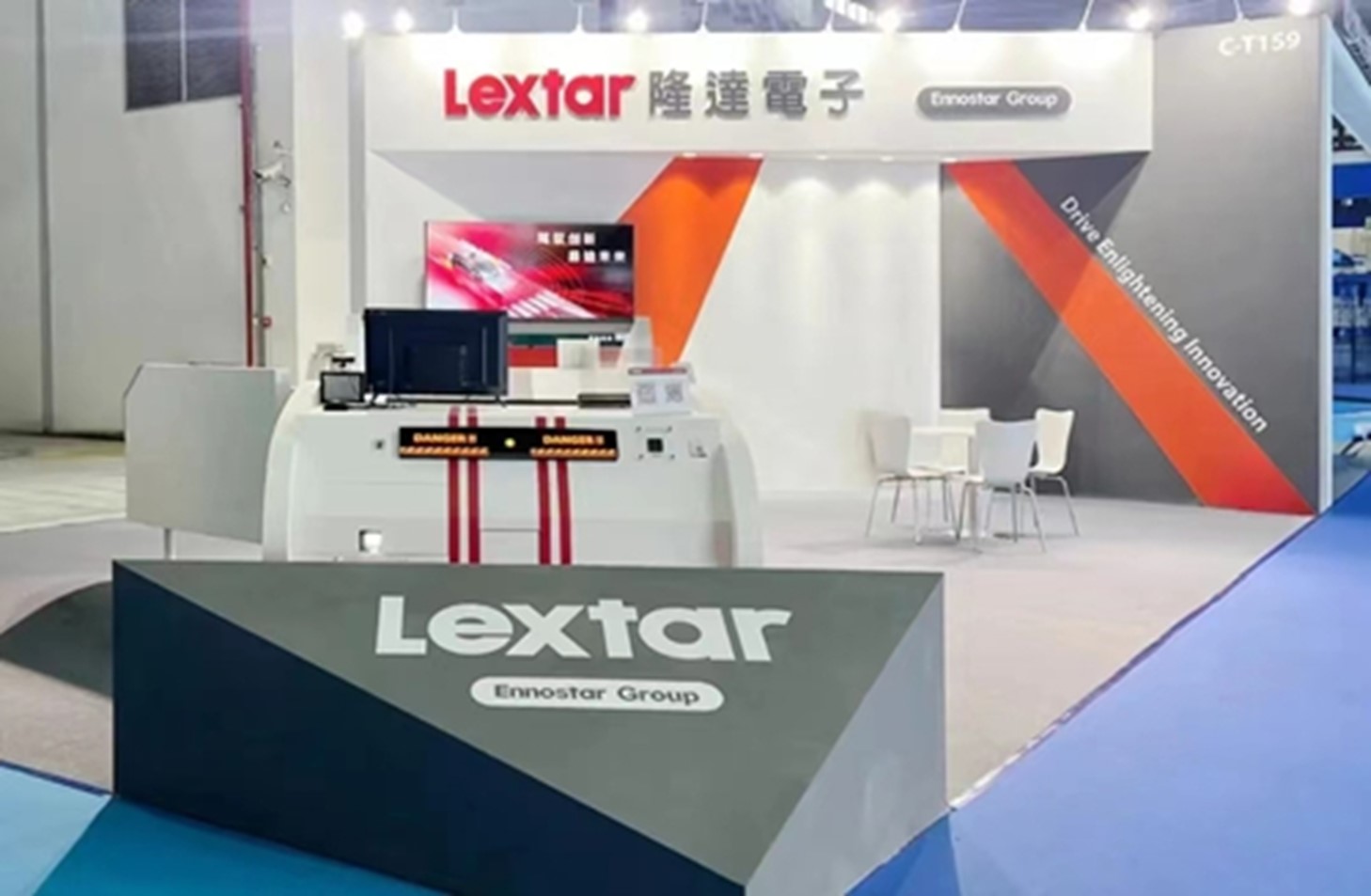
Lextar ADB headlight and interactive Mini LED headlight (image credit: Lextar)
Retop exhibited the front headlights called the GWM Ora Good Cat and Chery Omoda and intelligent ADB headlight modules. The standout among the on-site vehicle models featuring the company’s light sources was the AITO M9.
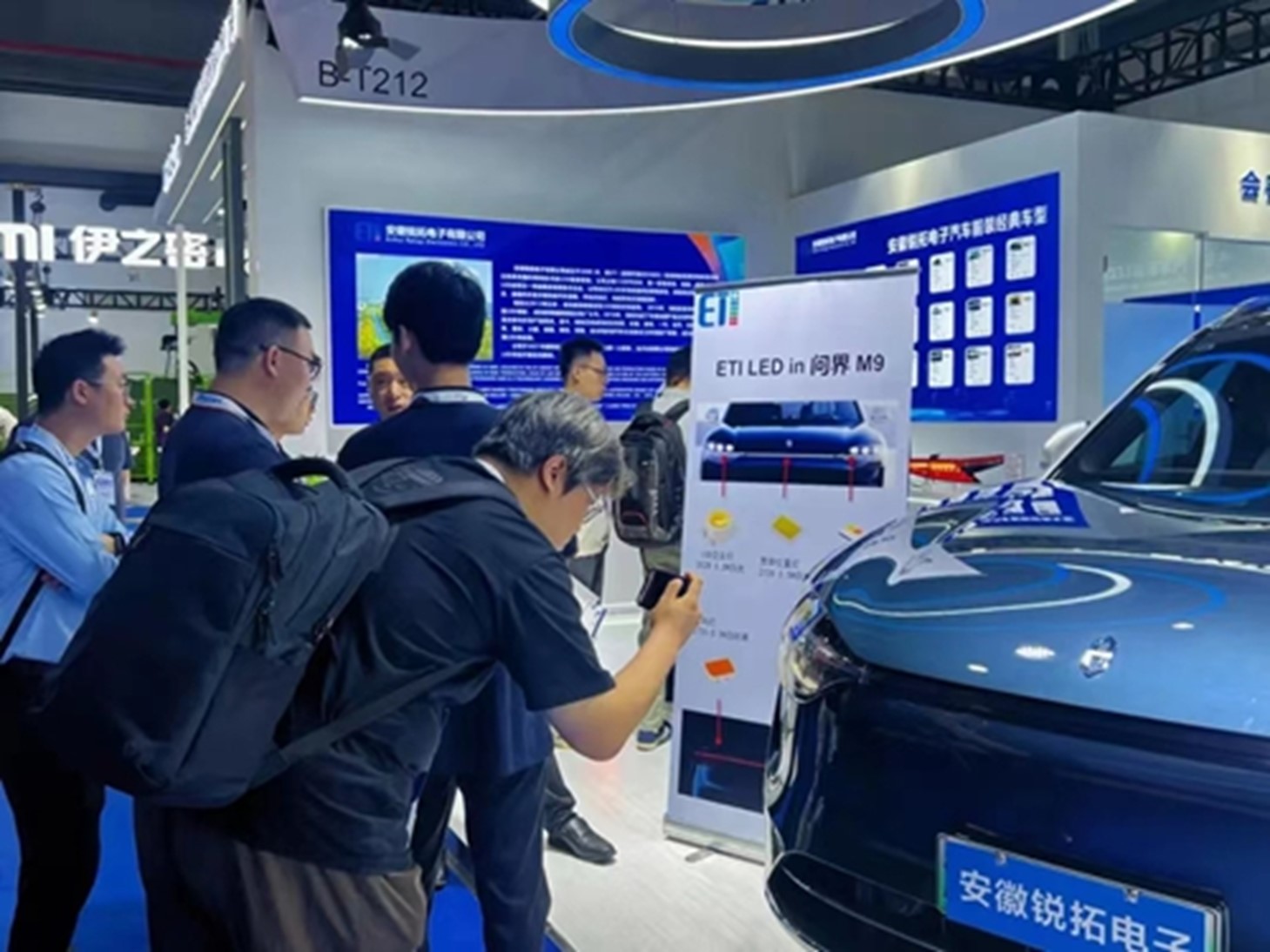
Retop LED light source applied to AITO M9 (image credit: Retop)
CHIPFOUNDATION presented Micro LED pixel headlight chips that can project quality light at a distance of 10 meters, delivering high brightness and high-definition projection effects.
Xingyu manifested its intelligent headlight for the AITO M9 model, featuring an 84-pixel ADB system developed in-house. The headlight can be synchronized with a million-level DLP module co-developed with Huawei, enabling precise masking of oncoming vehicles.
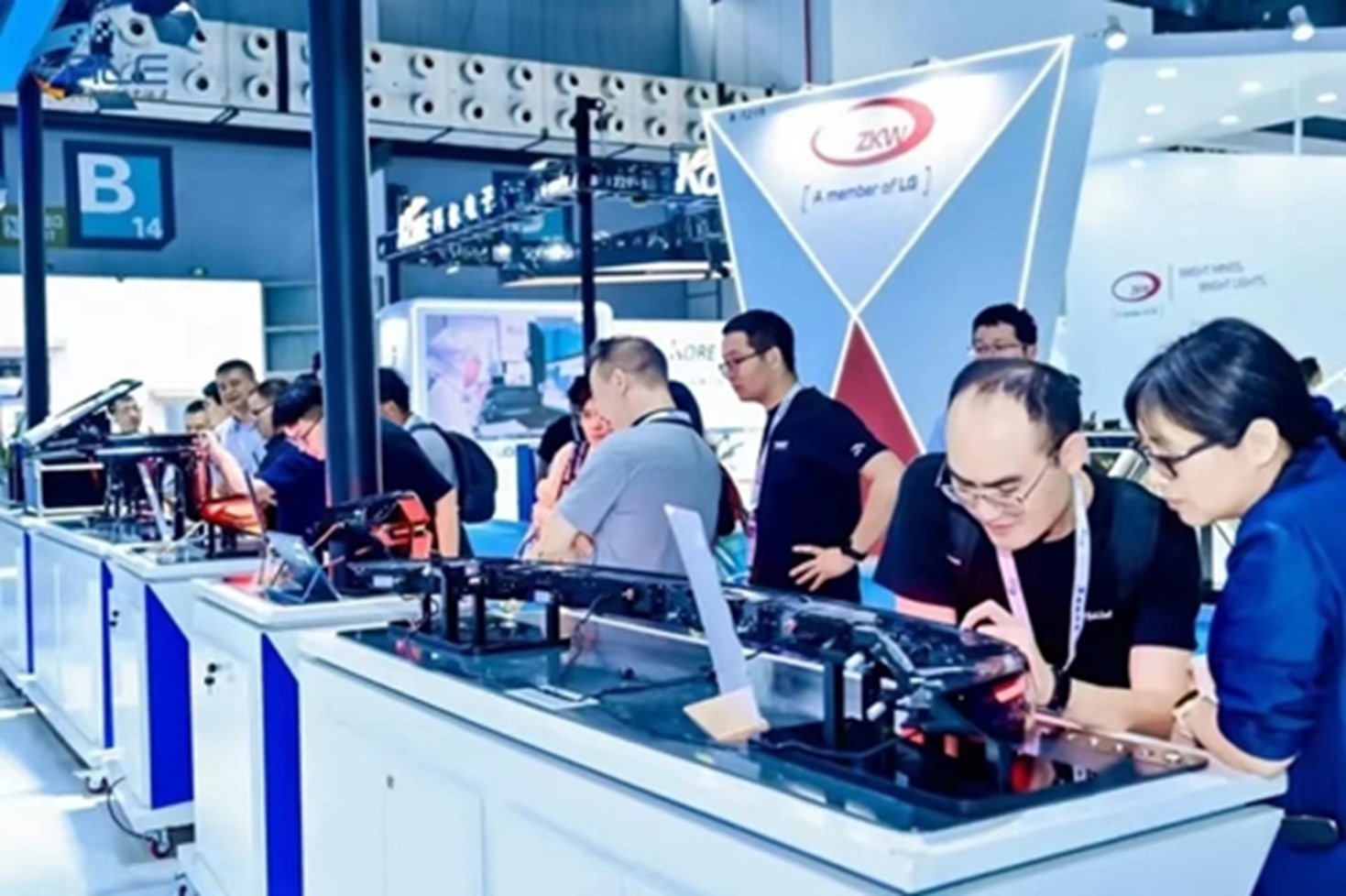
Xingyu automotive headlight (image credit: Xingyu Co., Ltd.)
Ledman demonstrated the Mount Bromo Eye headlight applied in the GWM Tank 700 model. It is the world’s first combination headlight to include a 3D spiral motion mechanism, offering a new dynamic hidden lighting module solution that can work with other lighting effects and high-tech illumination modules.
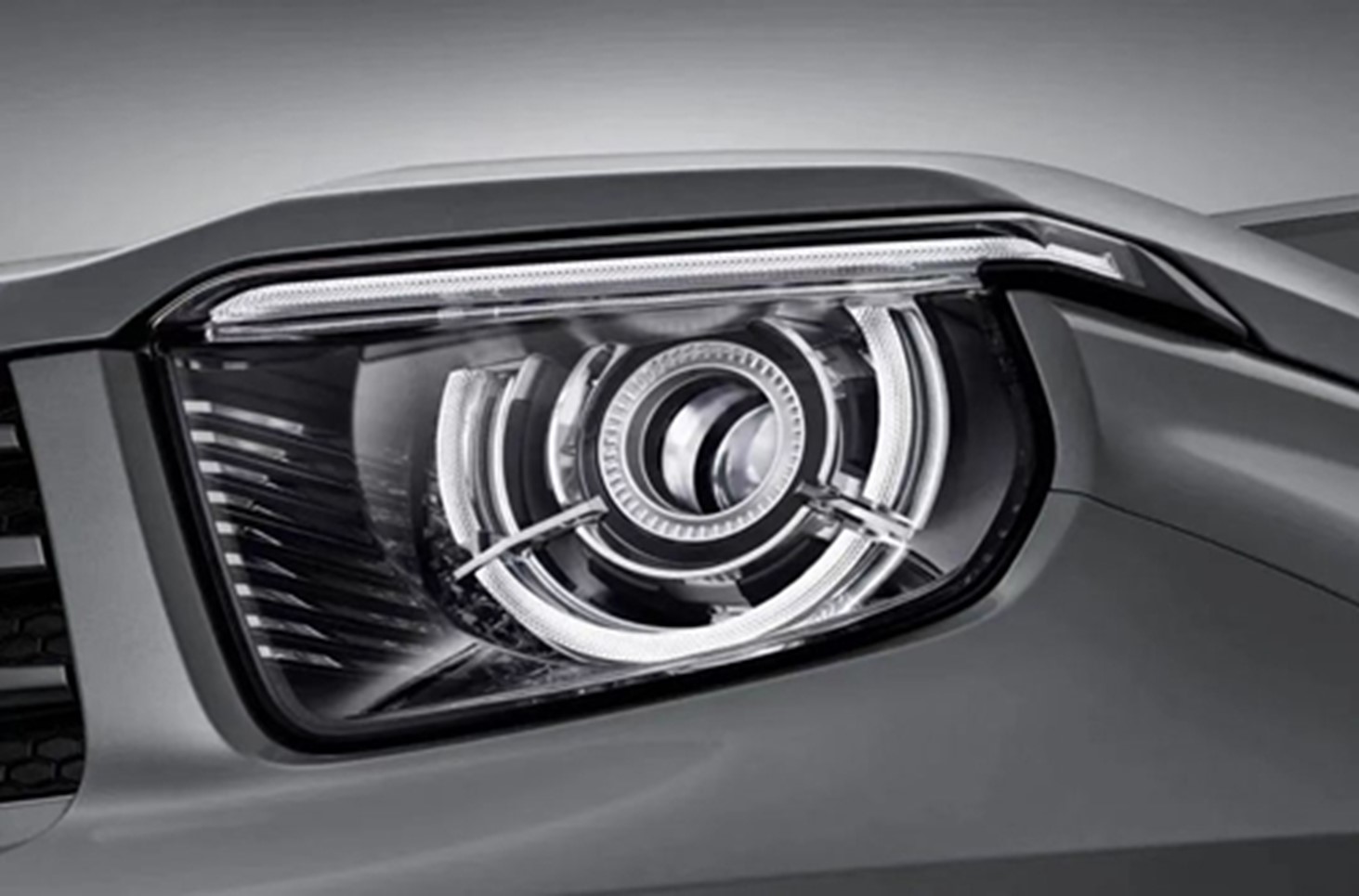
Ledman Mount Bromo Eye headlight (image credit: Ledman Optoelectronic Co., Ltd.)
Taillights
ams OSRAM, Seoul Semiconductor, LatticePower, LITEON, Lextar, and others showcased taillights based on Mini LED technology. The taillights feature high brightness, high contrast, and high resolution, supporting personalized design and information display. They also include interactive functionalities that allow information exchange with the driver and other road users.
ams OSRAM presented a 3D compact taillights and a full-width taillight based on the SYNIOS® P1515. The SYNIOS® P1515 automotive signal lights are engineered with ultra-small packaging and offer 360° radiation, enabling automakers to achieve vibrant and eye-catching taillight designs with a small number of LEDs or slim optical components.
Seoul Semiconductor introduced a Thin Red packaging solution to meet the demands of Mini LED taillights.
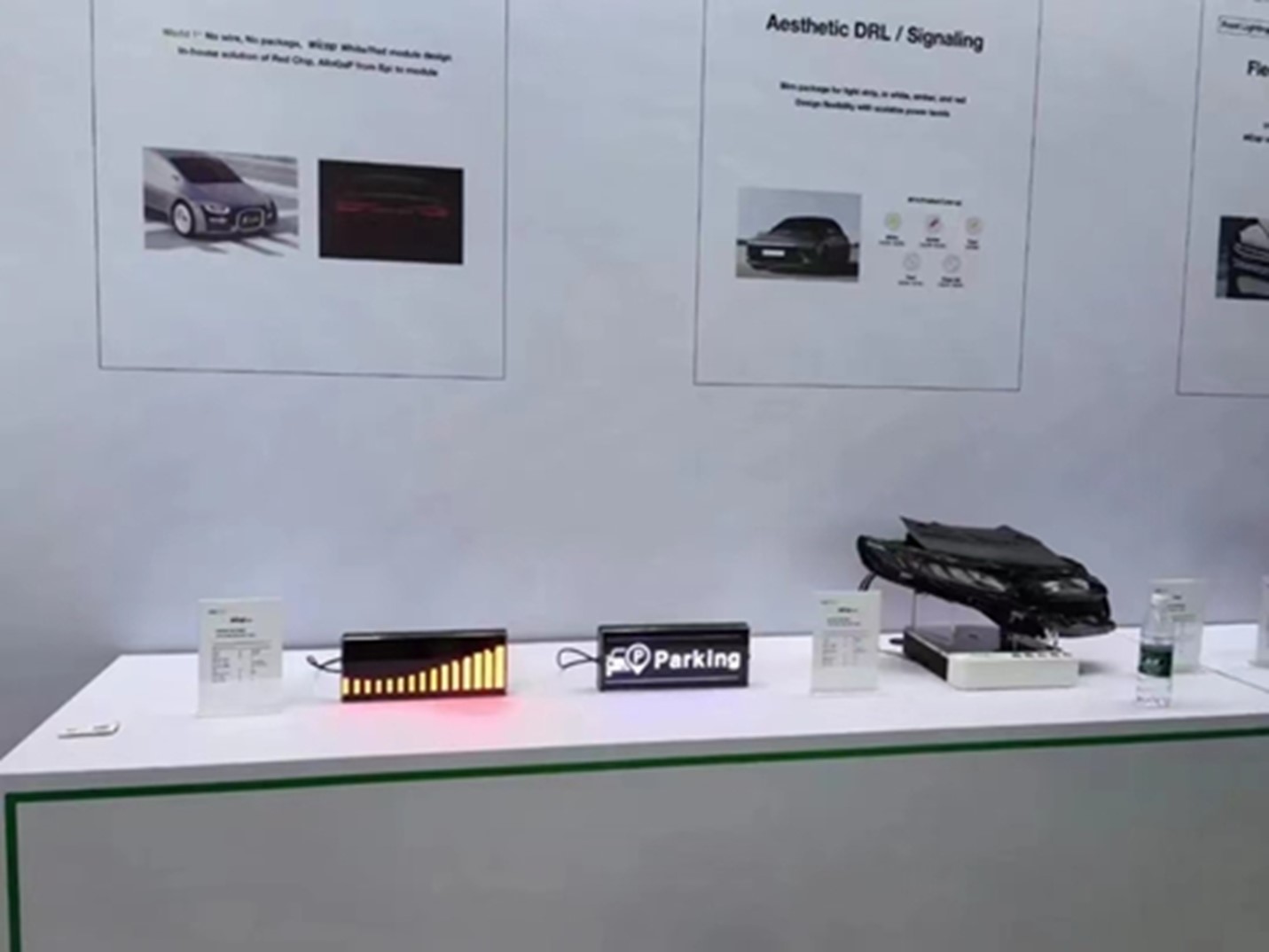
Seoul Semiconductor taillight solutions (image credit: Seoul Semiconductor)
LatticePower showcased its silicon-based interactive Mini LED taillight, which comes with a vertical chip design to achieve single-sided light emission. The extended distance between the P- and N-type regions enhances reliability, while improvements in packaging materials and bracket coatings contribute to high brightness and high contrast.
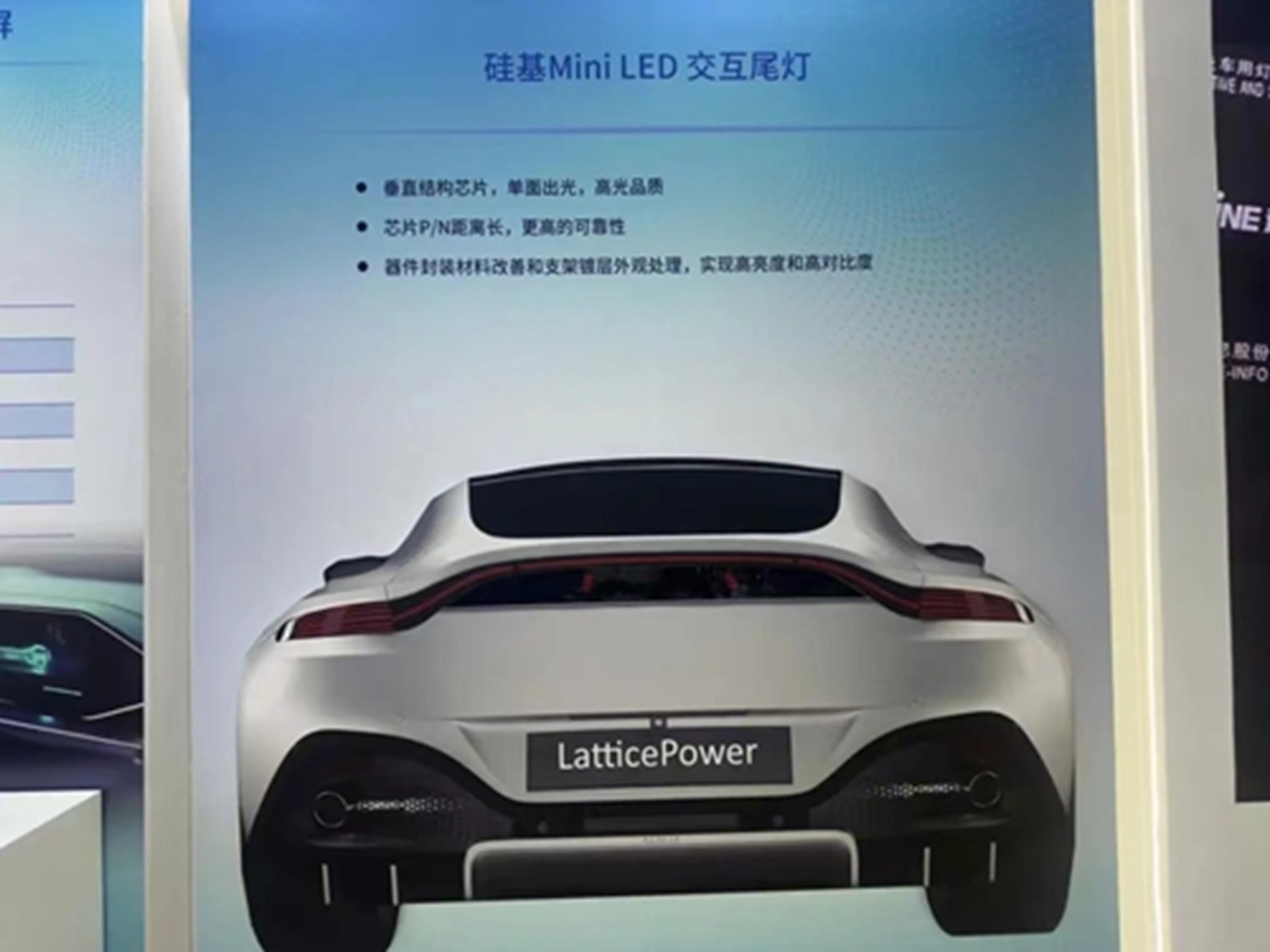
LatticePower interactive Mini LED Taillight Solution (image credit: LatticePower Corporation Limited)
LITEON displayed a series of intelligent automotive Mini LED taillights, characterized by high density, high brightness, high contrast, high resolution, and a thin profile. In addition to brake warning functions, these lights feature advanced human-car information transmission, applicable to personalized grille lamps and car taillights.
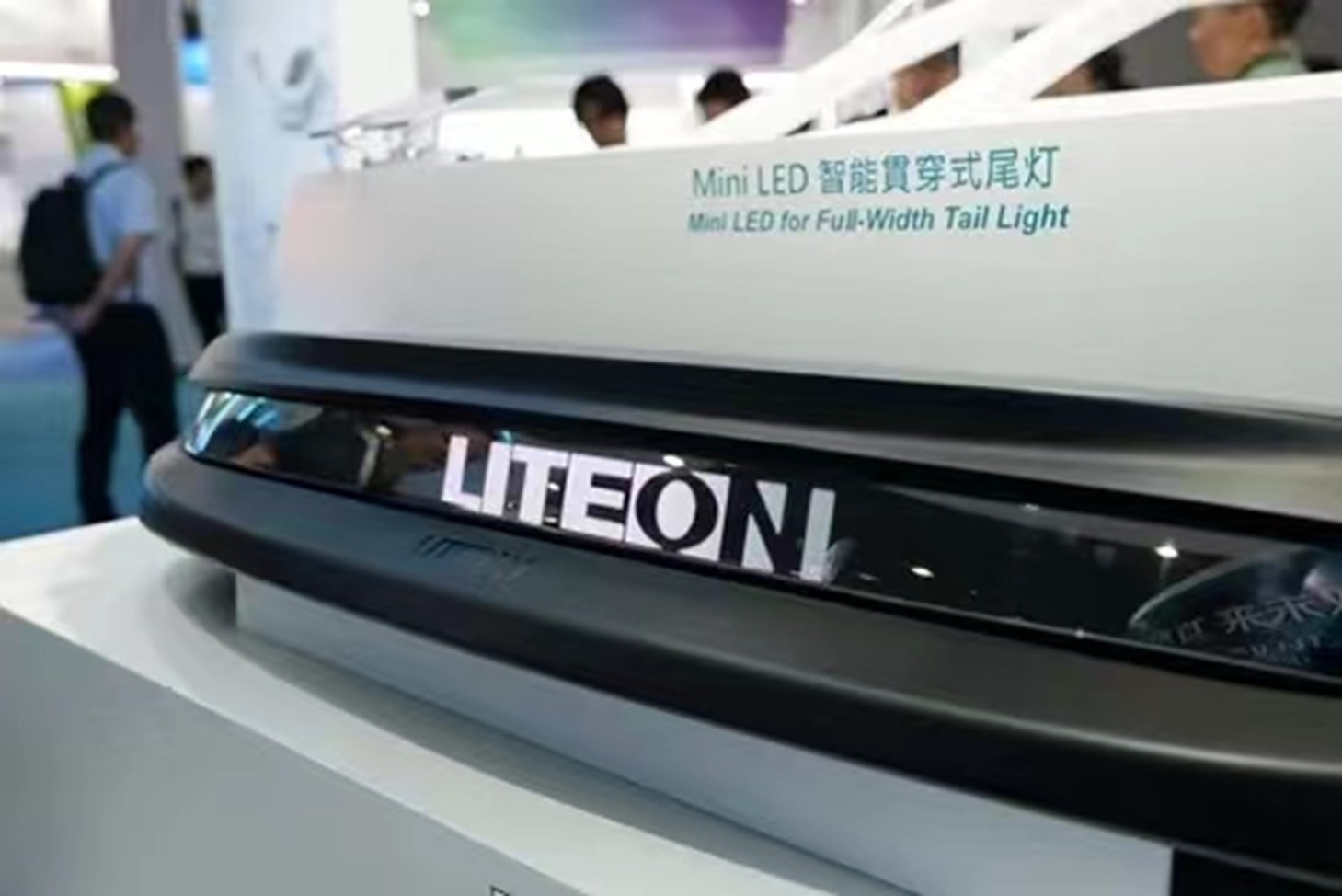
LITEON intelligent full-width Mini LED taillight (image credit: LITEON Technology)
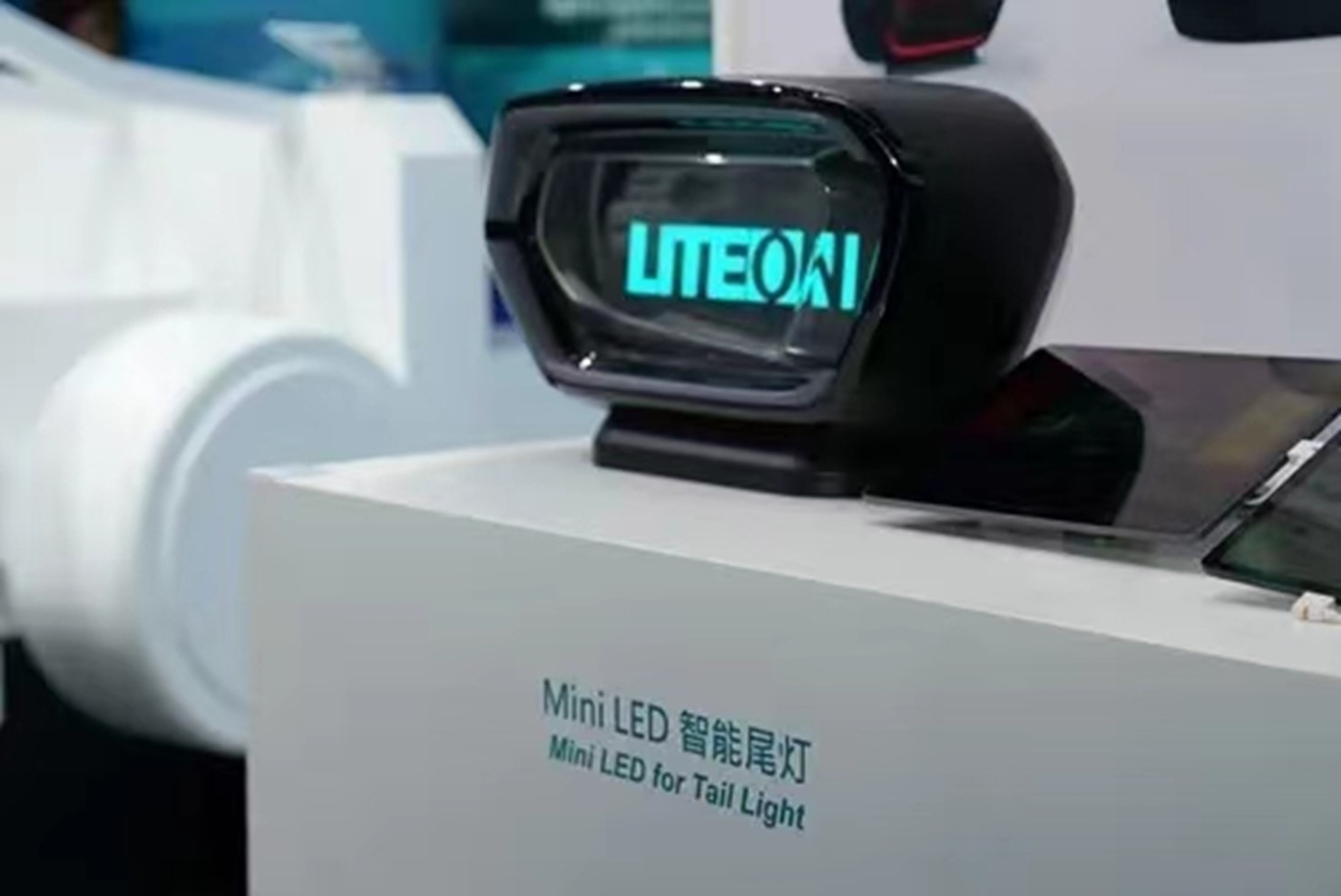
LITEON intelligent Mini LED taillight (image credit: LITEON Technology)
Lextar exhibited an ultra-red automotive tail display, with the modules offering high brightness, high contrast, and high grayscale display effects. The Mini LED light supports high-pixel local dimming, allowing dynamic adjustment of display patterns according to driving situations.
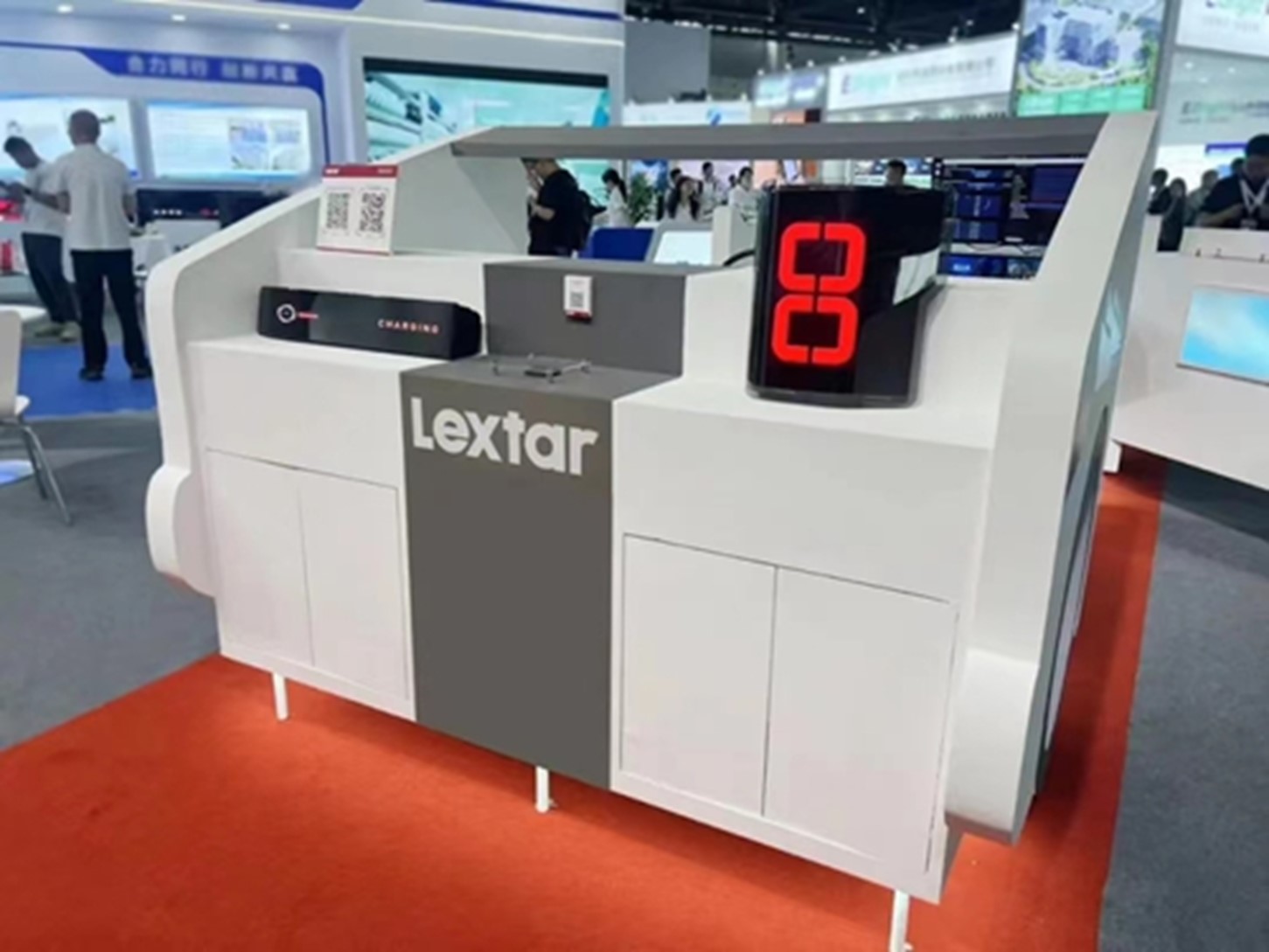
Lextar ultra-red automotive tail display and Mini LED interactive RGB light (image credit: Lextar)
DOMINANT Opto Technologies showcased its SVx-ASS for taillights, which features ultra-low thermal resistance, high thermal lumen output, compact packaging size, and a higher operating temperature range. This facilitates better heat dissipation and flexible lighting design, making it suitable for high-temperature environments.
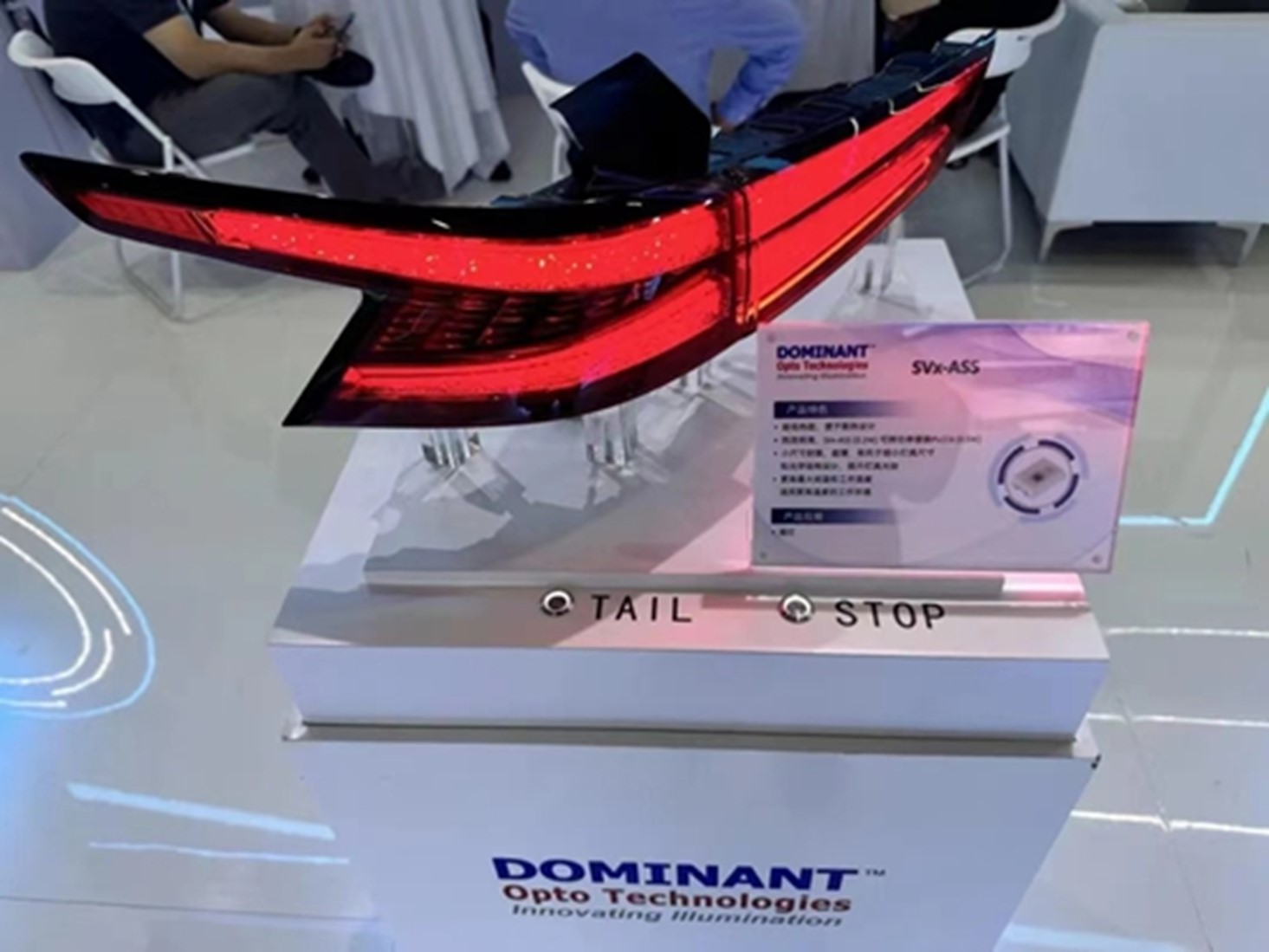
DOMINANT taillight solution (image credit: DOMINANT Opto Technologies)
Xingyu presented mass-produced products such as the full-width tail light for the Li L6.
Ledman presented a waist drum-shaped taillight that combines fiber optic technology with LED light sources. The transparent material securing the optical fibers creates a floating lighting effect and enables intelligent functions such as signal lighting, music synchronization, welcome and farewell animations, and connectivity with smart devices.
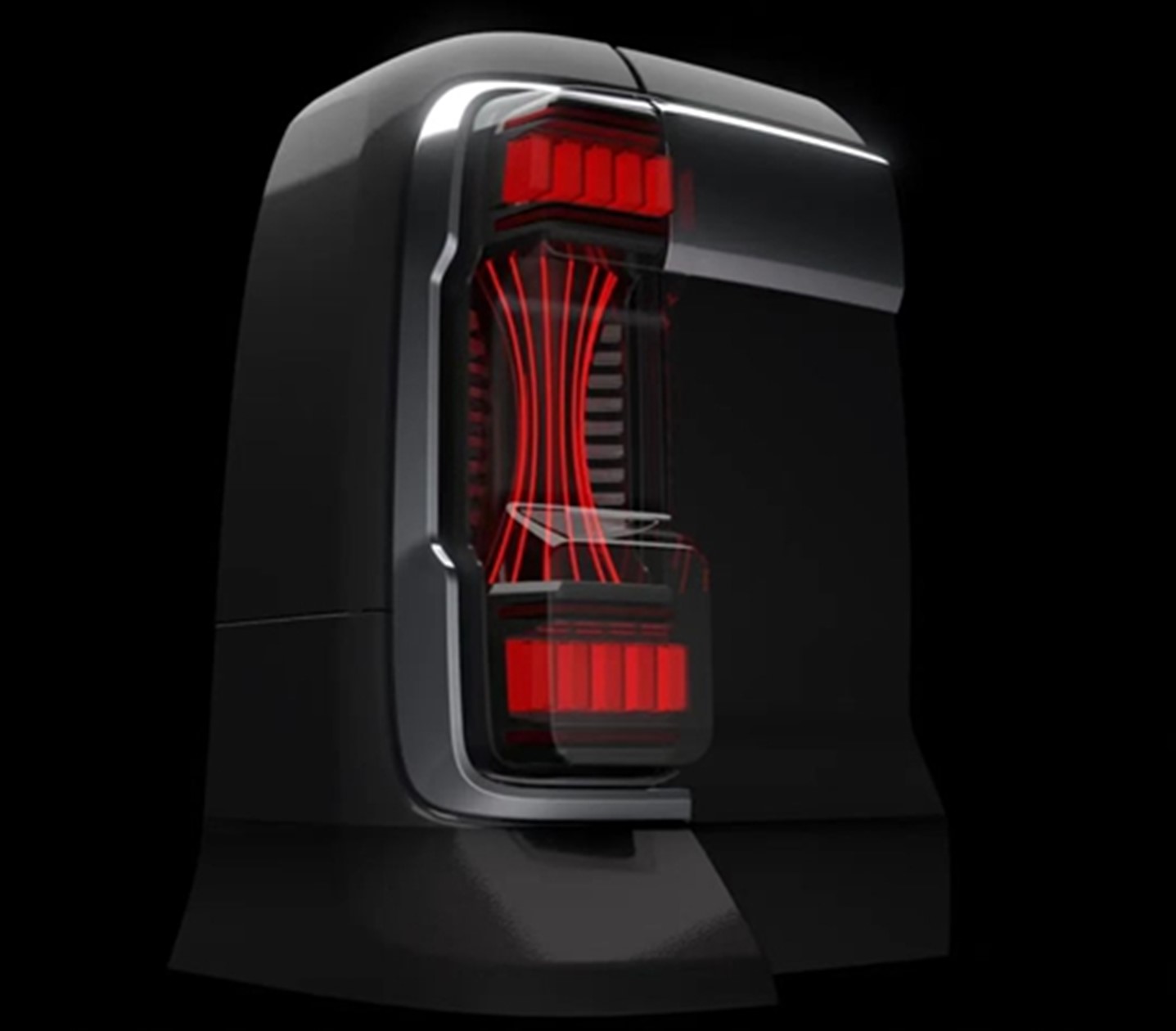
Ledman waist drum-shaped taillight (image credit: Ledman Optoelectronic Co., Ltd.)
Combination Lights, Ambient Lights, Marker Lamps
During ALE 2024, combination lights, ambient lights, and marker lamps were also highlighted. Specifically, ambient lights feature more personalized and intelligent designs. Companies such as ams OSRAM, Seoul Semiconductor, Nationstar, Honglitronic, LIGHTNING, SUNPU, DOMINANT Opto Technologies, and Brightek displayed related products.
ams OSRAM showcased a variety of solutions, including the RGBi LED Board, OSIRE® E5515 in-mold decoration indicator demo, smart surface RGBi ambient lighting, intelligent in-cabin matrix reading lights, RGBi demo, and RGBi ultra-thin interior ambient lighting.
Notably, the lamp maker presented the OSIRE® E5515, designed specifically for modern automotive interior ambient lighting with RGB “side-emitting” LED functionality, along with intelligent interior bus (OSP) systems and stable wavelength EEL technology at the ALE exhibition.
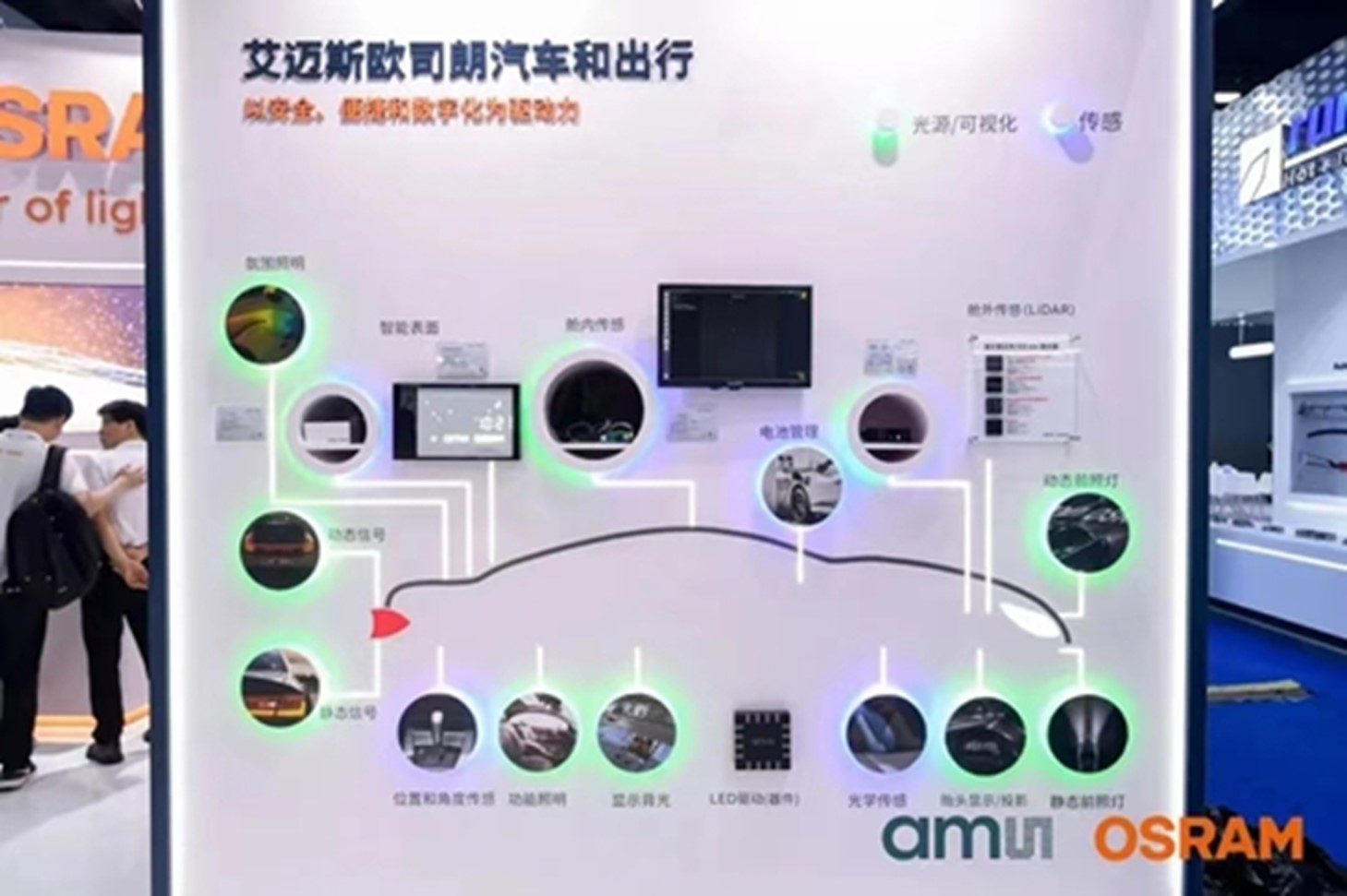
ams OSRAM automotive solutions (image credit: ams OSRAM)
Seoul Semiconductor has developed the Cyan WICOP, targeting the needs of autonomous driving. This technology uses high-current and high-power illumination to clearly indicate to oncoming vehicles and pedestrians that the car is operating in an autonomous driving mode. Additionally, the Cyan 3014 LED meets car manufacturers’ requirements with its low-current and low-power functionality. The company also showcased the SunLike LED, a white ambient lighting product that has been applied in the Volvo EX90 and Polestar 3 models.
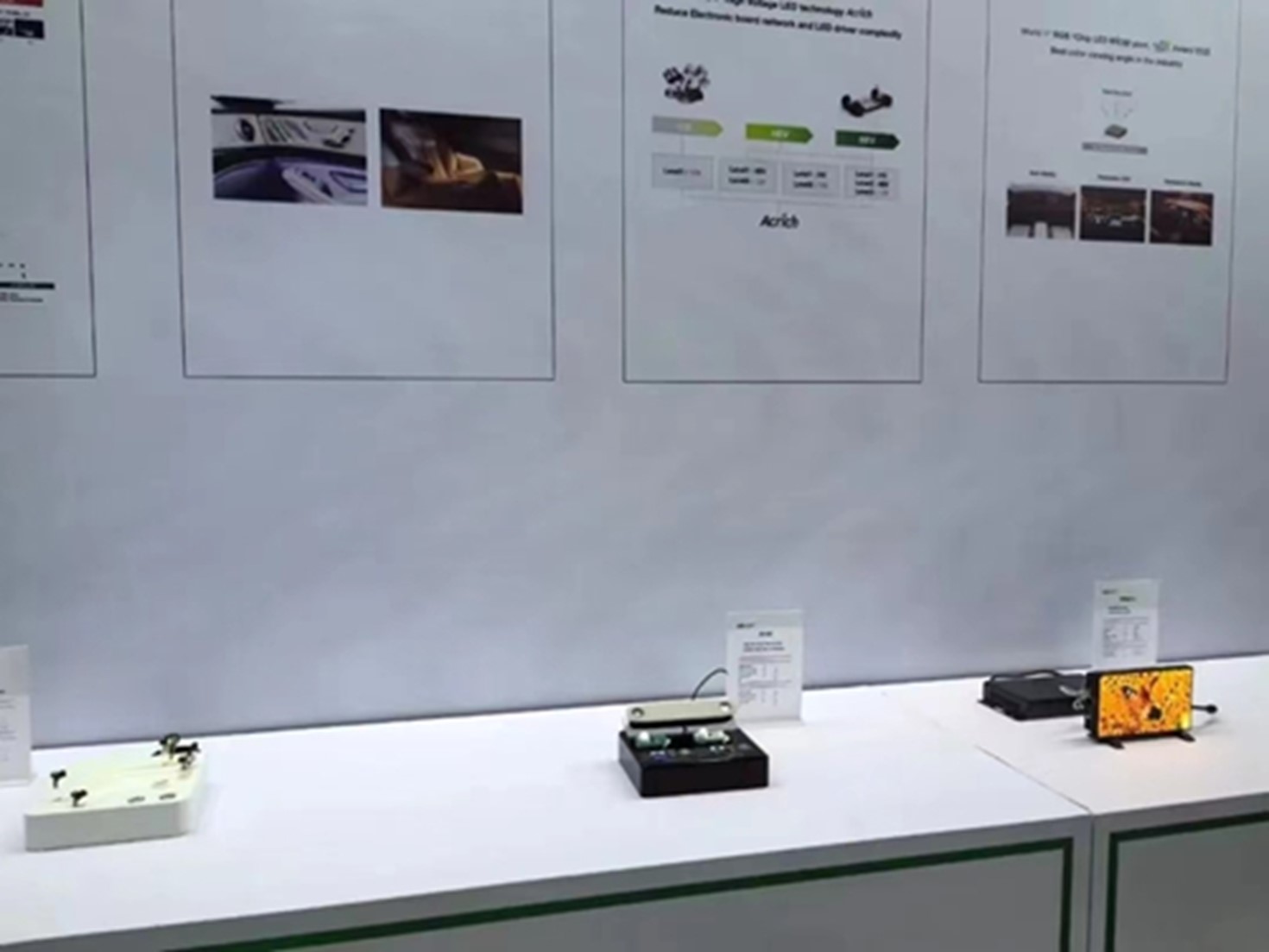
Seoul Semiconductor ambient lighting solutions (image credit: Seoul Semiconductor)
Nationstar presented various lighting solutions, including front combination light sources (daytime running lamps, logo lights, headlights, intelligent driving indicators, and front turn signals), rear combination light sources (rear lights, rear turn signals, brake lights, license plate lights, high-mounted brake lights), interior ambient lights, in-car backlights, and exterior interactive lights. The company offers customizable technical solutions based on customer needs.
At the exhibitor’s ambient lighting section, visitors could see the mass-produced 3433PLCC6 RGB and the upcoming IC RGB. These products are made of PLCC and offer high color saturation, making them suitable for ambient lighting and other interior applications.
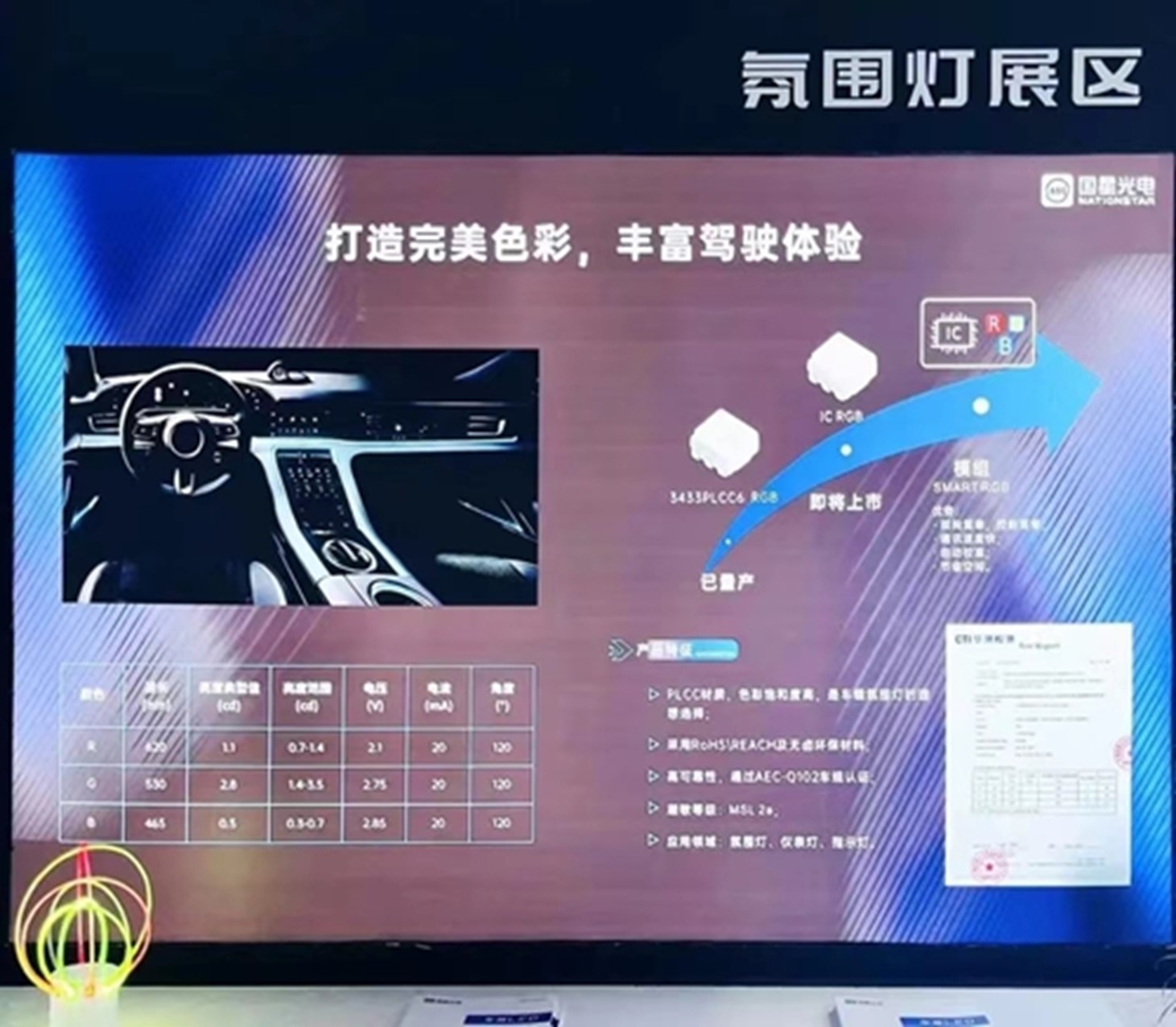
Nationstar ambient lighting section (image credit: Nationstar)
Honglitronic demonstrated its ISC Smart Lighting series, which offers both general LED and Mini LED solutions. These lights can interact with drivers and vehicles by receiving various scene signals via CAN input.
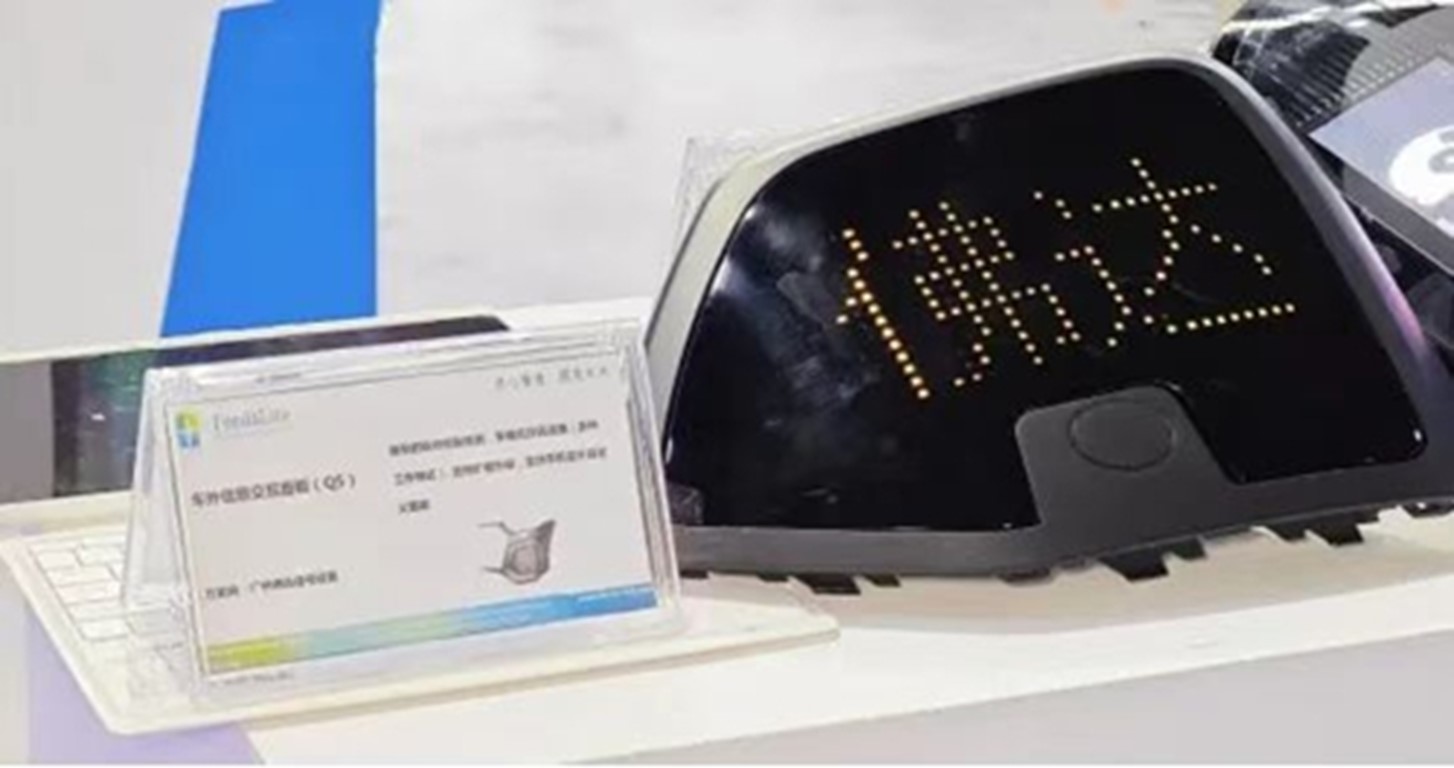
Honglitronic ISC Smart Lighting series (image credit: Honglitronic)
The company also introduced three new ambient lights: dual-color indirect light RGB, single light guide multi-surface emitting RGB, and crystal RGB ambient lights, as well as door panel ambient lights, dual light guide gradient color ambient lights, and a grille lamp series with a hidden lighting effect achieved through paint and laser engraving techniques.

Honglitronic intelligent grille lamp series (image credit: Honglitronic)
In terms of combination lights, Honglitronic displayed several smart car lamps, including the Geely HC11 rear side and full-width light, Geely E245 grille lamp combined with a front bumper light, Chery T1P-FL3 front full-width light combined with daytime running lights and grille lamps, as well as front and rear combination lights for BAIC, and front combination lights for Hozon Auto.

Honglitronic produces the HC11 rear side and full-width light for Geely (image credit: Honglitronic)
Refond showcased its second-generation 1818 interactive lamp LED, which features a smaller size and higher pixel density. The product’s colloid color is subdued, and the surface is brushed with ink to present a visible-light-but-hidden-lamp effect. Each LED emits light uniformly over its surface, making it compatible with grille lamp and functional lighting applications.
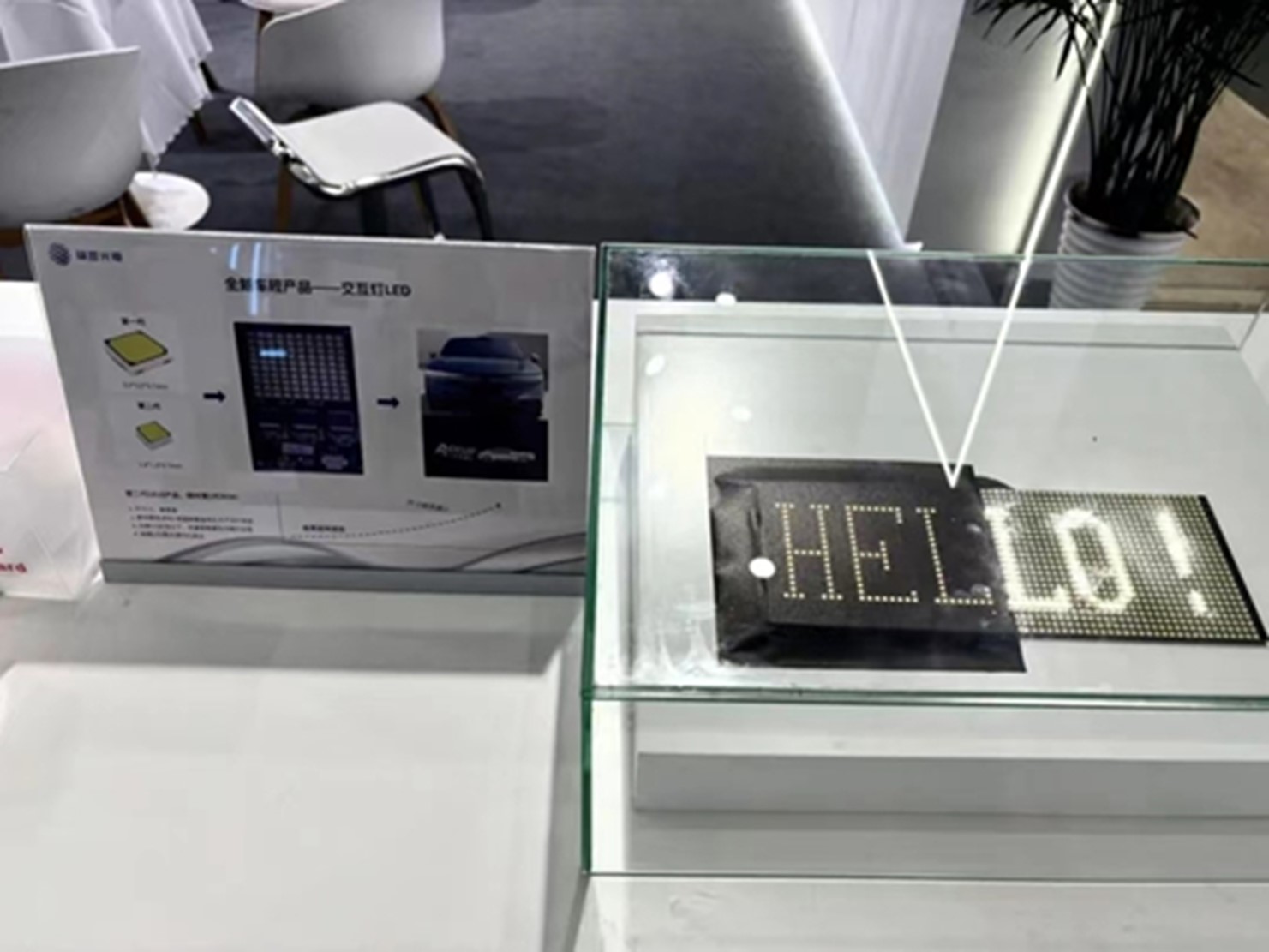
New automotive interactive lamp LED from Refond (image credit: Refond Optoelectronics)
LIGHTNING demonstrated its Combination Headlight LED product solution, focusing not only on improving the luminous efficiency of the LEDs themselves but also on enhancing light output efficiency and headlight module efficiency through the combination of LES (light-emitting surface). This ultimately reduces the power consumption of headlights.
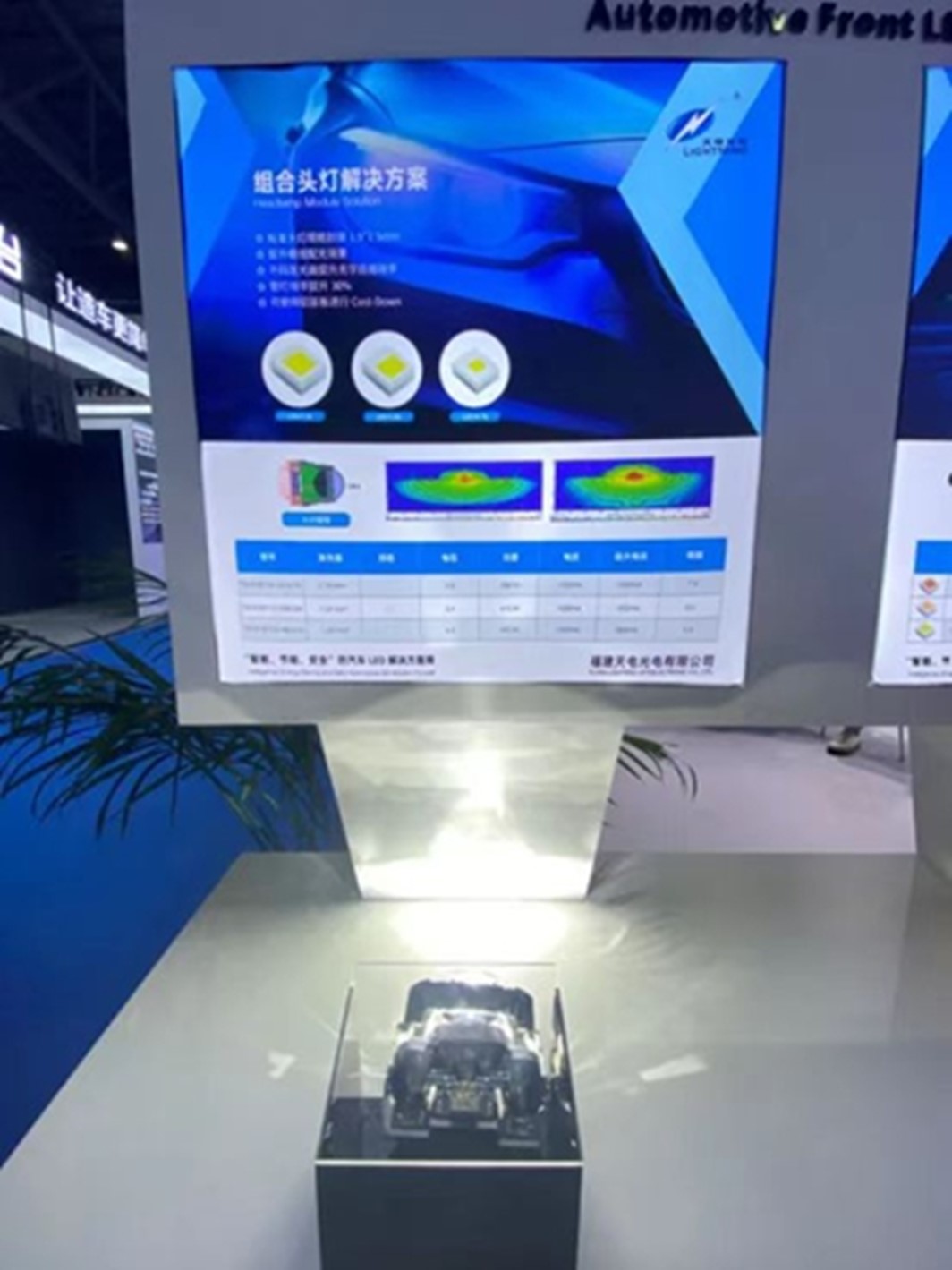
LIGHTNING Combination Headlight LED product solution (image credit: LIGHTNING)
The company also presented an RGB+IC LED ambient lighting solution, which enables single-point control for a more intelligent, scene-based cabin.
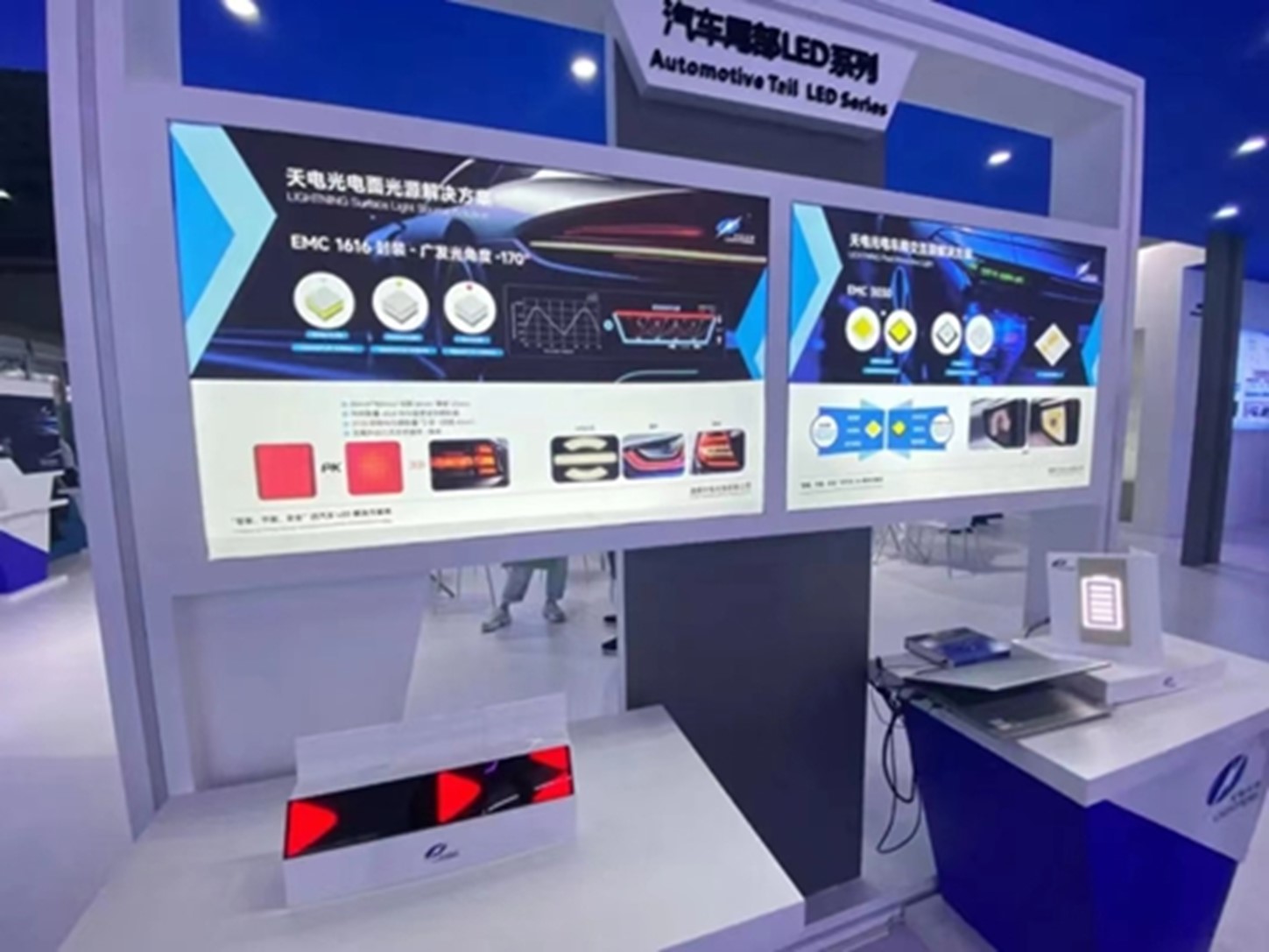
LIGHTNING interactive automotive display solution (image credit: LIGHTNING)
SUNPU presented a series of innovative LED lighting devices, including the ADS marker lamp, ambient lights, automotive sterilization lights, and projection lights. The manufacturer also introduced the concept of anti-fatigue driving light sources for the first time. After years of exploration in the field of human-centric lighting, SUNPU discovered that the circadian factor can inhibit the secretion of melatonin in the human body, and proceeded to introduce related light sources into automotive applications for the first time.

SUNPU ADS marker lamp and other products (image credit: SUNPU LED Co., Ltd.)
Additionally, SUNPU exhibited the second- and third-generation LED beauty lamps and solutions suitable for in-car applications. These products come with the latest packaging structures, designed to provide illumination for passengers in the car, achieving beauty-enhancing effects.
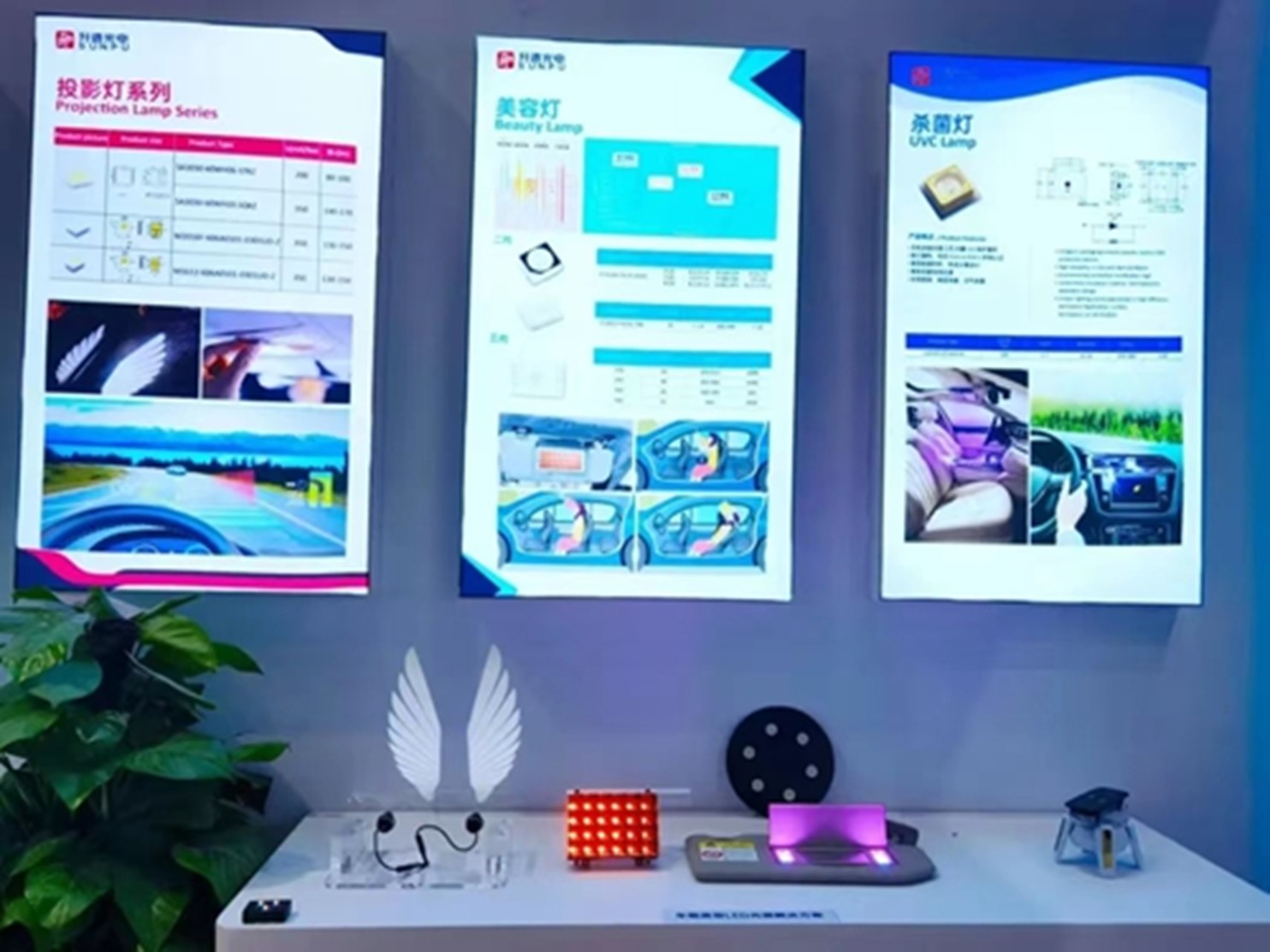
SUNPU beauty lamps, sterilization lights, and projection lamps (image credit: SUNPU LED Co., Ltd.)
DOMINANT demonstrated its ambient lighting applied in the A3D-MHG-2000-1, featuring high brightness, zero flux binning, self-diagnostic, and automatic temperature compensation and adjustment, ensuring light and color consistency, product reliability, maintenance efficiency, and performance stability.

DOMINANT ambient light (image credit: DOMINANT Opto Technologies)
Brightek showcased its iCLed automotive ambient lighting series and the latest EVO platform. The EVO iCLed platform, with 16 million times the color richness of conventional IC LEDs and a brightness of 7,000 mcd, broadens the range of applications. The iCLed series on display also integrated various sensing technologies such as gesture, touch, and voice recognition. Coupled with Brightek’s dimming algorithms, these features significantly enhance color calibration efficiency.
Xingyu presented mass-produced products including the BMW X5 rear combination light, as well as an HD projection lamp and radar-lamp fusion product.
Automotive Displays
During the exhibition, Micro LED automotive displays were showcased, with Seoul Semiconductor, Macroblock, and Lextar being major exhibitors. Moreover, Mini LED display technology continued to garner attention, with Macroblock, BOE HC SemiTek and MLED, LatticePower, Refond, and APT presenting their latest Mini LED automotive displays.
Seoul Semiconductor showcased a Micro LED display using its WICOP Pixel technology, with a pixel pitch of 0.625mm and a pixel density of 40 ppi. The display integrates 54,000 LEDs and achieves a brightness of 1,000 nits.
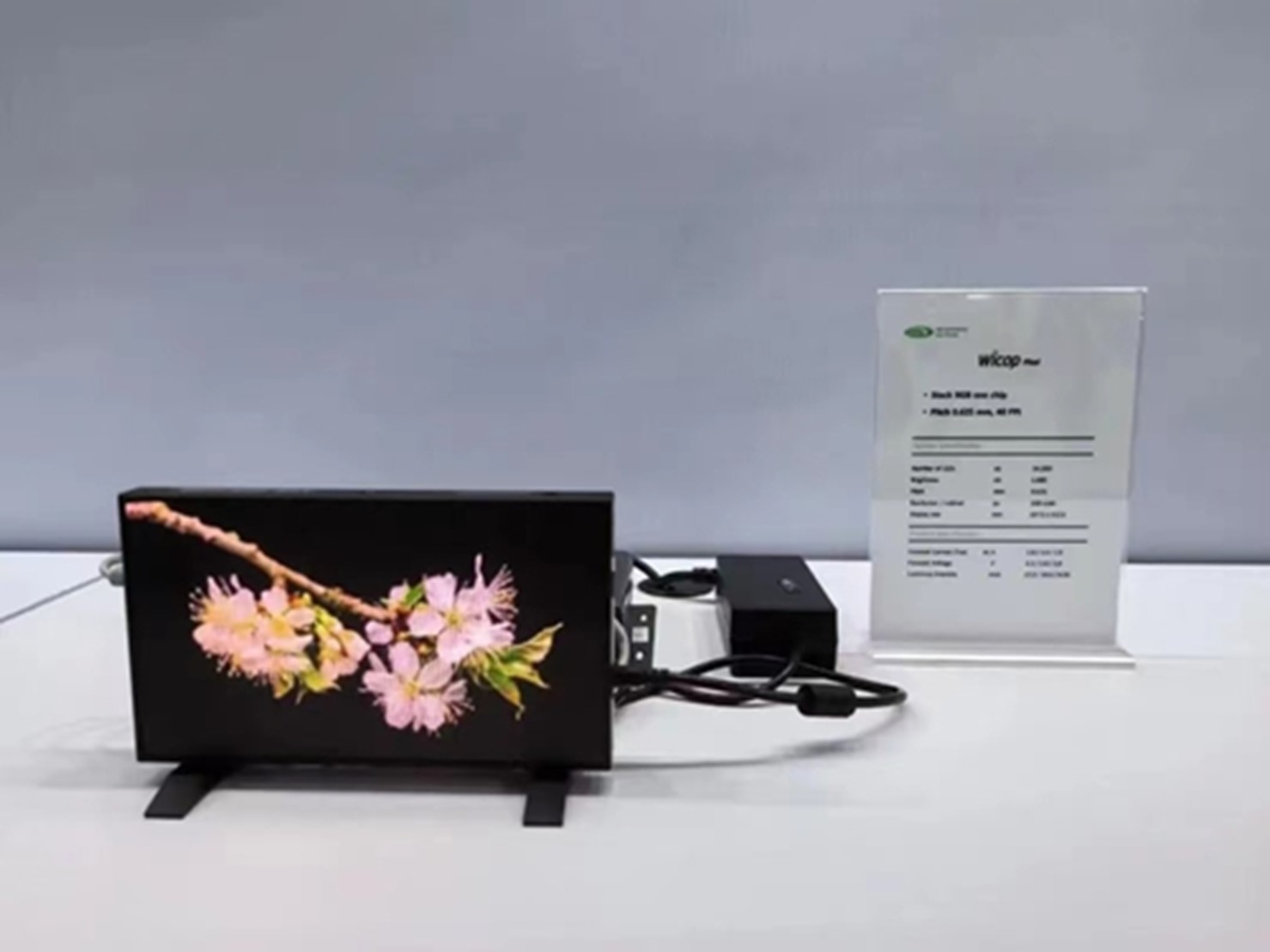
Seoul Semiconductor Micro LED display (image credit: Seoul Semiconductor)
Macroblock featured a Micro LED electronic side mirror in the intelligent cabin section, utilizing its MBI5780Q common-cathode driver IC. This design relocates the side mirror inside the vehicle to reduce wind resistance and consequently lower energy consumption. Regarding display performance, the product boasts high brightness to prevent glare interference, fine image quality, and 16-bit grayscale.
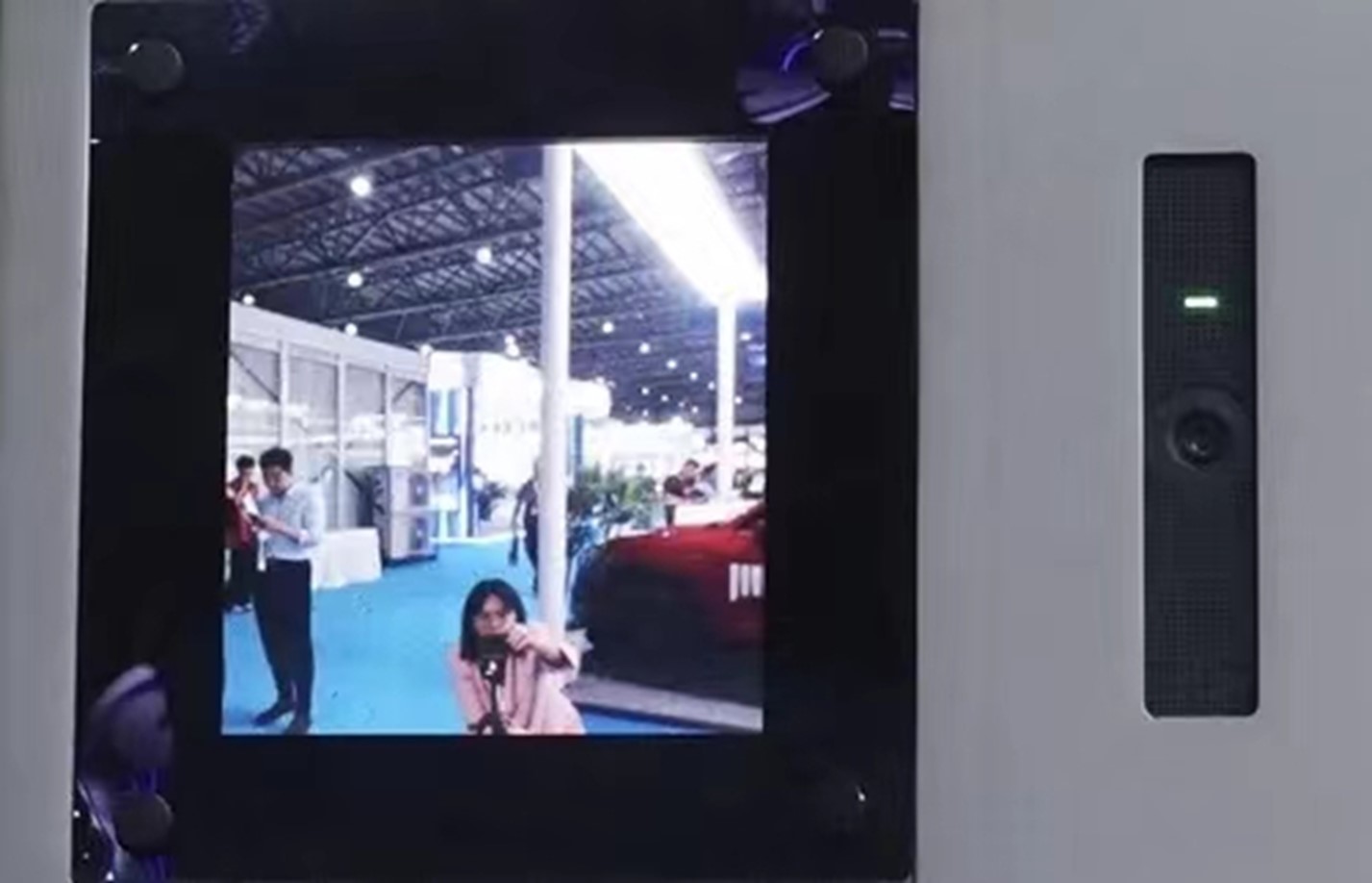
Macroblock Micro LED electronic side mirror (based on the MBI5780Q driver IC; image credit: Macroblock)
The company also exhibited 12.3-inch and 15.6-inch Mini LED-backlit displays for smart cabin applications, coming with both PCB and glass substrate solutions. Additionally, it showcased a Mini LED backlight module with a glass substrate, equipped with the MBI6306Q AM (active matrix) LED driver IC. This module supports 6 channels, small current ranging from 0.1 to 10mA, and 8-bit PAM dimming.
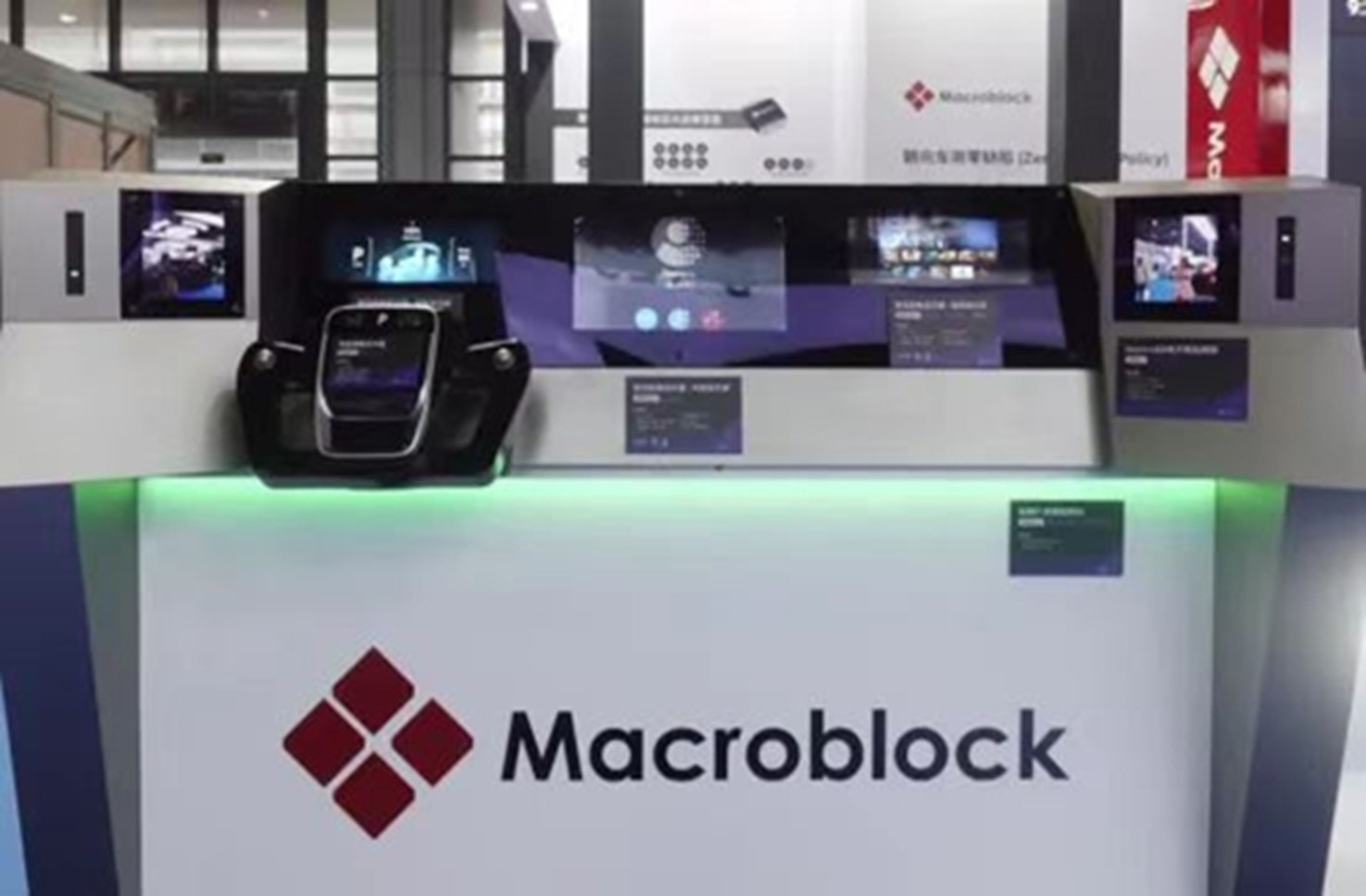
Macroblock Mini LED-backlit display (PCB and glass substrate solutions; image credit Macroblock)

Macroblock exhibits a Mini LED backlight module with a glass substrate (powered by the MBI6306Q; image credit: Macroblock)
LatticePower unveiled a 12.3-inch automotive Mini LED display with 1,380 dimming zones, a resolution of 1920x720, a color gamut of 90%, a brightness of over 1,000 nits, and a contrast ratio of up to 1,500,000:1.
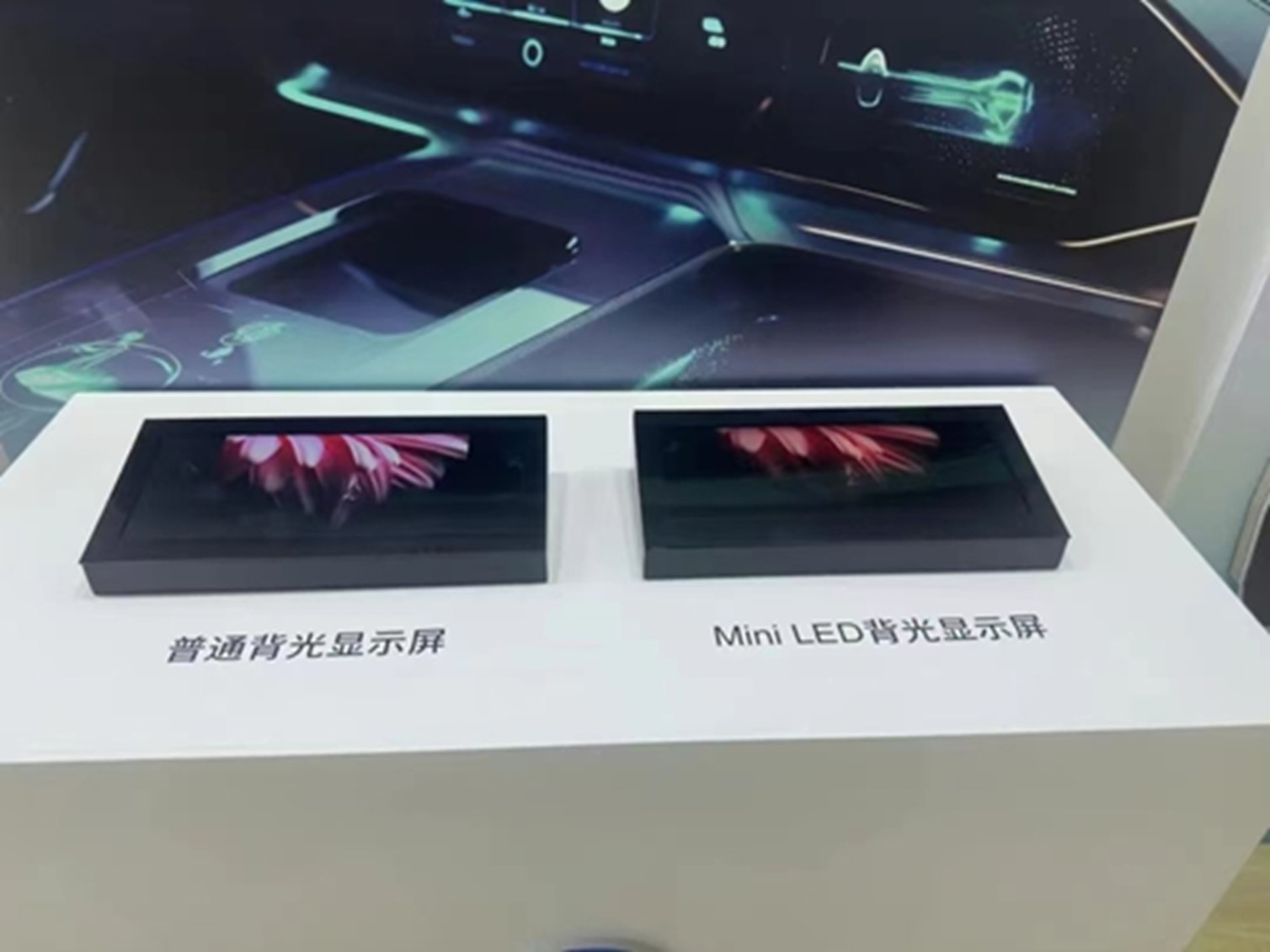
LatticePower presents its 12.3-inch automotive Mini LED display and compares the display effect with a general backlight display (image credit LatticePower)
Lextar presented a transparent Micro LED display with a transmittance rate of up to 65%, suitable for heads-up displays, windows, and sunroofs. This display offers a brightness of 2,000 nits, providing road conditions and entertainment functions to drivers and passengers based on their needs.
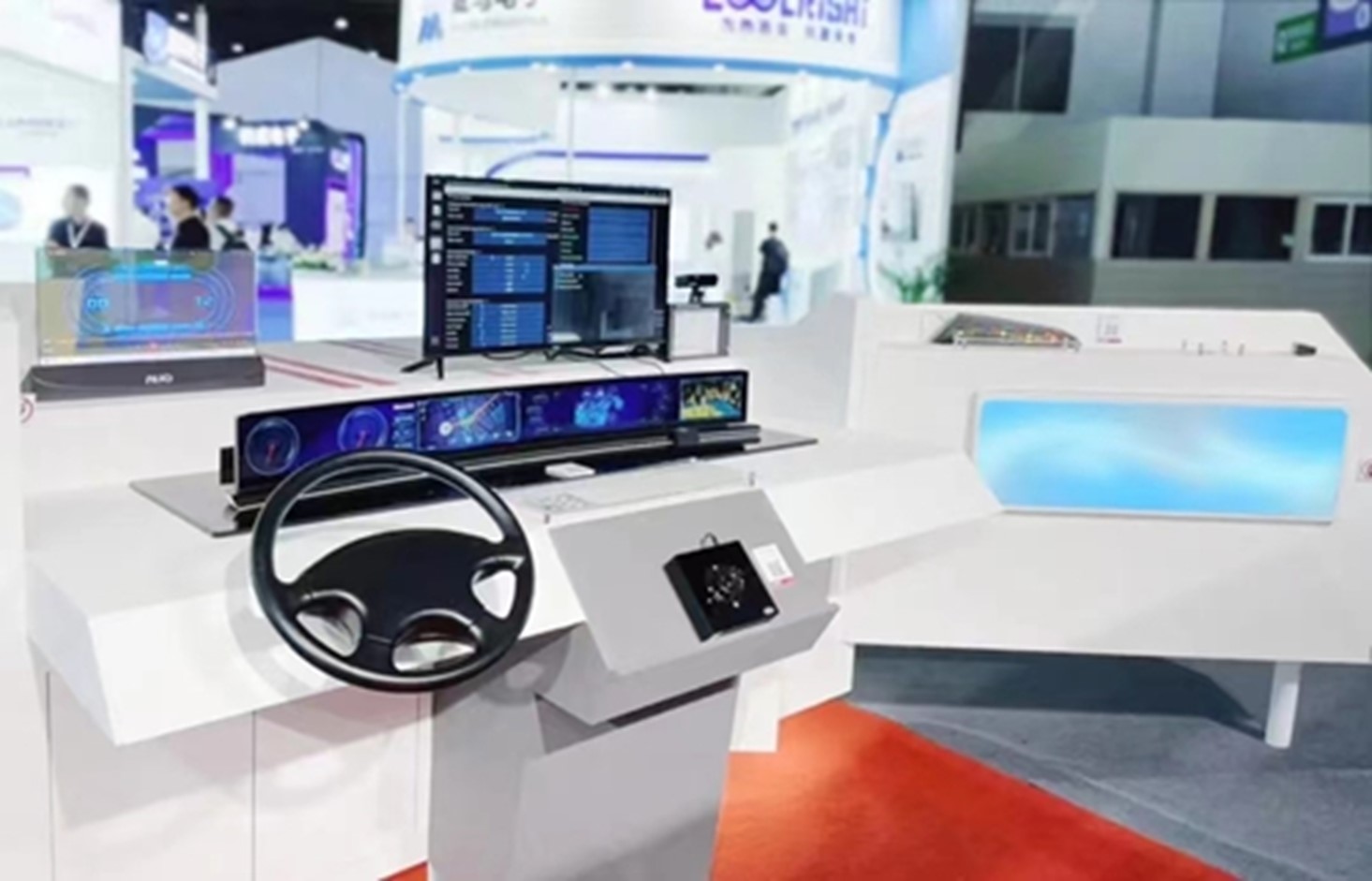
Lextar transparent Micro LED display and full-array local dimming automotive panel (image credit: Lextar)
BOE HC SemiTek and MLED jointly presented their Mini LED display solutions, including a 12.3-inch Mini LED LCM solution primarily for automotive center consoles and dashboards, and a Mini LED COB automotive display solution for exterior applications such as car body and interactive lights. The 12.3-inch Mini LED LCM features ultimate contrast and brightness control. The P0.9 COB 27-inch screen boasts excellent environmental adaptability and exceptional image quality, making it suitable for a wide range of uses and scenarios.
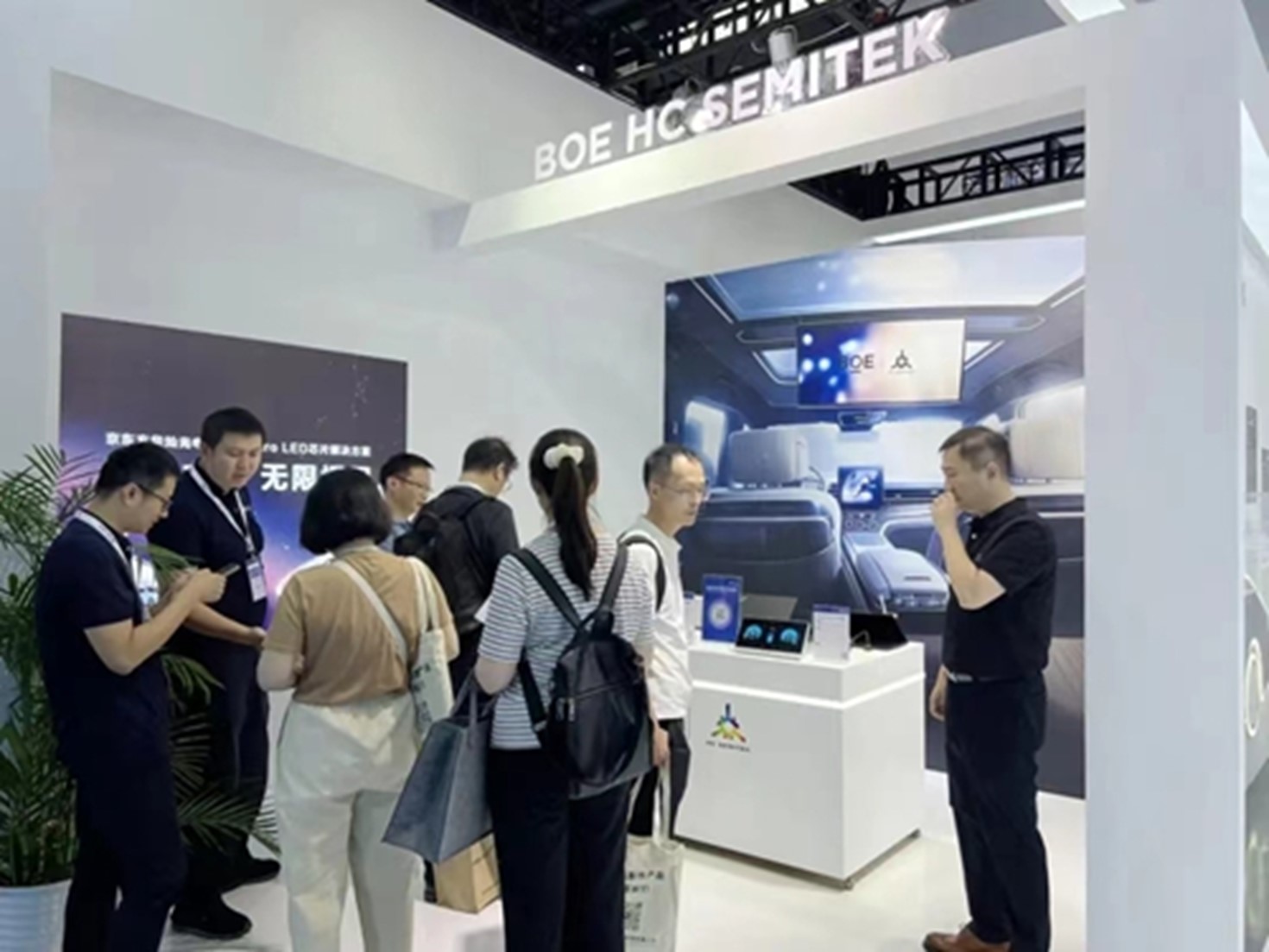
BOE HC Semitek 12.3-inch Mini LED LCM solution (image credit: BOE HC Semitek)
Nationstar presented a dot-matrix interactive screen characterized by high brightness, low power consumption, high contrast, and saturated light spots. This screen can be integrated with car hoods, grille lamps, and taillights, working alongside automotive intelligent interaction systems to enable personalized light communication displays.
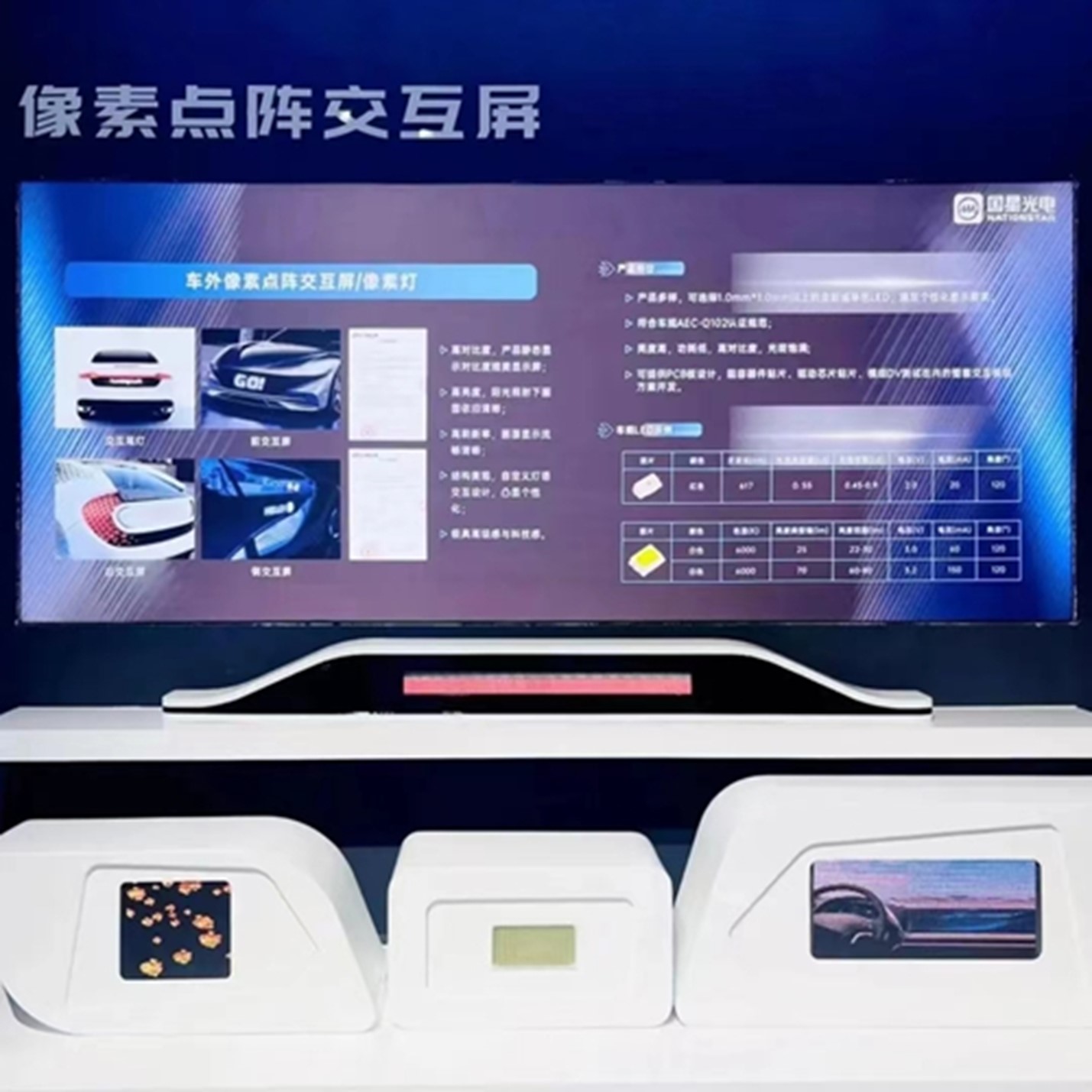
Nationstar dot-matrix interactive display (image credit: Nationstar)
Refond showcased an automotive Mini LED dynamic logo light. Featuring a pixelated design, the product supports LVDS, CAN, and automotive Ethernet communication methods as well as OTA updates. Users can choose different pixel pitches and color modes, such as monochrome, white light, or full-color RGB. The product is also customizable, complies with the AEC-Q standards, and is compatible with the AutoSAR architecture.
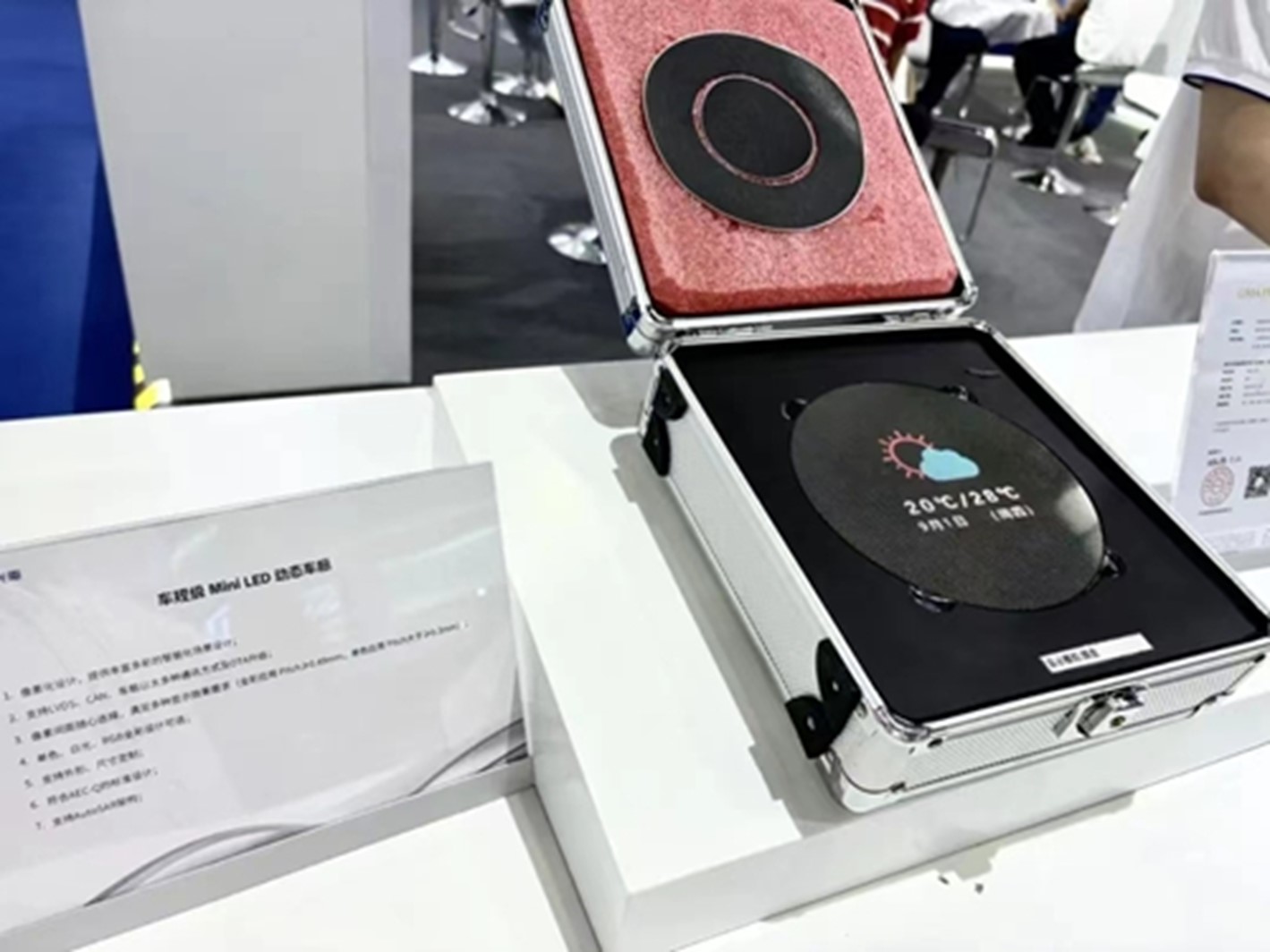
Refond automotive Mini LED dynamic logo light (image credit: Refond Optoelectronics)
APT demonstrated its Mini 1010 RGB P1.5 full-color interactive display, Mini 1010 RRR P1.5 red light interactive display, Mini 1010 RGB P3 full-color interactive display, and Mini 1010 RRR P3 red light interactive display. These products offer high brightness, high reliability, and low power consumption, with dynamic effects that achieve seamless splicing.

APT exhibits various products including a Mini 1010 RGB P1.5 full-color interactive display (image credit: APT Electronics, Co., Ltd.)
Conclusion
The automotive market is currently experiencing intense competition and pressure to reduce costs. Price wars have continued in 2024, exacerbating the profitability challenges for NEV (new energy vehicle) brands and further straining the financial conditions of car manufacturers. Additionally, the automotive industry has initiated new cost-cutting races in technologies and materials.
According to TrendForce’s report “The 2024 Global Automotive LED Market: Trends of Lighting Products and Displays”, car manufacturers are actively marketing high-value-added products such as ADB headlights, Mini LED taillights, full-width taillights, grille lamps/full-width front light bars, (intelligent) ambient lights, and Mini LED-backlit displays. This trend is expected to drive steady growth in the demand for automotive lights and automotive LEDs in 2024, reaching $37.395 billion and $3.445 billion, respectively, surpassing the overall automotive market shipment. This trend was also evident at ALE 2024.
Among these high-value-added products, ADB headlights are particularly receiving market attention. According to TrendForce, the penetration rate of LED headlights in conventional passenger cars globally reached 72% in 2023, with the penetration rate in electric vehicles even higher at 94%. These rates are expected to increase to 75% and 96% respectively in 2024.
The exhibited products at this show indicate that various innovative technologies and products such as ADB headlights, Mini LED taillights, ambient lights, and Mini/Micro LED displays are continually advancing towards maturity. With the development of advanced display technologies like Mini/Micro LED, consumer expectations for automotive lights and LEDs are likely to rise, driving LED-related companies to sustain investment in research and innovation. By introducing and promoting high-value-added automotive LED product technologies, car manufacturers can maintain a competitive edge in this fierce market and lay a foundation for future market growth (by Mia from LEDinside).
TrendForce 2024 Global Automotive LED Market- Lighting and Display Product Trend
Release Date:
1. PDF (180 Pages)- 30 June 2024
2. EXCEL- 30 June 2024 and 31 December 2024
Languages: Traditional Chinese / English
|
If you would like to know more details , please contact:
|























































